#mino talks zesty
Text
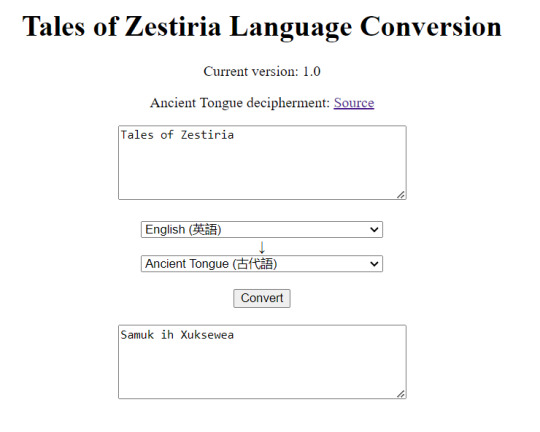
I made a tool to convert English alphabet to languages found in Tales of Zestiria (so both Modern Glenwood language and Ancient Tongue) and vice-versa, hosted on my own Neocities here. It was something done quickly so it's definitely not the most optimized (not that it needs to be) and I haven't tested if there's any bug yet. Please do report any bug if you find any!
98 notes
·
View notes
Audio
--Credits--
Lyrics: Kirvee (shoutout and big thanks to @talesofsymphoniac for help with writing for rhythm and flow and being my biggest supporter through the whole process, as well as minoath for checking my lyrics for meaning and accuracy to the best of our abilities)
Vocals: Nickolas Forsten
Mixing: Michael Fewkes
Song: “Calling” originally done by fhana for Tales of Zestiria the X ED1
Download the uncompressed version here!
(Lyrics are beneath the cut and wall of text below)
This is something I’ve been sitting on for longer than I really wanted to be, because I was looking for someone to sing it.
I’d been wanting to try my hand at lyric adaptation for a while and Calling was the 2nd song I ever attempted to do that with. It’s also, of the songs I’ve adapted so far, the one I’m most proud of for how the lyrics came out. I am so supremely proud of these lyrics and that’s why I’m really excited to finally be able to show it to more than a select few people! So please enjoy it!
A bit of background:
I approached this the same way I usually approach a translation, except in this case the goal was to make a translation fit into singable English rather than just be a straight translation. For this song, in addition to my own translations in some spots, I primarily followed @minoath‘s translation and she helped me through the process to make sure I was getting the proper meanings across even while rewording or rearranging some parts.
While the first season of Zesty’s anime was airing, Mino made a post that talked about Calling and Anemone no Hana being answers to one another lyrically and from Sorey and Mikleo’s perspective respectively. While adapting the lyrics, this is the same angle I decided to take with Calling and it’s why I was specifically seeking a male singer for it.
The lyrics were already more-or-less clearly Sorey’s perspective, but while adapting I reworked and added some parts as needed to make lines fit or flow better while keeping it in that perspective. For that reason, you can think of these lyrics as being Sorey at the end of the game, either addressing Mikleo directly or thinking about Mikleo and everyone else as he enters his sleep with Maotelus.
The biggest of those changes happened in the Outro where I changed the original lyrics’ reference to God and made it about Maomao instead. It may not follow the translation quite as well, yeah, but it flows so much better and there was no nice and neat way to accurately adapt that part of the song.
I’ve talked enough now, so please enjoy this English cover of a wonderful song!
--Lyrics--
Verse 1:
On this journey of no return
When I close my eyes midway through it now
I want to sleep in this brief time of peace
While holding on to our wishes some way somehow
Bridge 1:
The world we dreamed of so long together
Is illuminated now in light
With the overflowing passion we share
Look at what our hope conceived
Chorus:
For our tomorrow's sake let's rest our wings for now
So we can smile and laugh here in this moment together
Don't you think when this long journey's at its end
We'll be able to grasp fragments of our calling with certainty
Let's just sleep right here for now and paint our dreams, don't you waver
Verse 2:
If we bridge the gap between them
Will the whole world smile bright and not condemn
We don't yet know if it'll be alright
But that's something we can keep believing, right?
Bridge 2:
Sometimes our world is full of miracles
That appear beyond our wildest dreams
One day soon that dazzling beautiful light
Will rain down upon us too
Chorus 2:
Someday I'm certain we’ll
Fulfill this purest oath made with the land
When everything is healed it will be okay
For the sake of gaining that tomorrow now
We have shed our blood and sweat and tears
We have walked through countless frays
You can't see it yet but I won't be led astray
Bridge 3:
I believe our calling now wasn't fate or destiny
It's a dream we're reaching for working endlessly
Our hands carve it with pain together
Outro:
For our tomorrow's sake let's rest our wings for now
So we can smile and laugh here in this moment together
To restore his blessing to the whole world now
Please live on, nurture, and grow your soul as you live on day to day
And then let's just sleep right here again tonight and remember
Let's go there together
Want to use these lyrics to sing your own version? You’re more than welcome to as long as it’s not for profit! If you do, please send me a link! I’d love to check it out!
#Tales of Zestiria#Tales of Zestiria the X#Sormik#Sorey#Calling#Tumblr was a dick and randomly decided to revert to an old version of the song and refused to take the corrected version???#so here I am reuploading the correct version I'm so sorry TT TT#I'm upset
63 notes
·
View notes
Text
Zestiria and Shinto

I think it’s very understated that Zestiria takes a lot after Shinto (compared to say, how people keep bringing up its Arthurian inspirations, despite those inspirations being superficial relatively), especially when it’s the essence of the game itself, but I suppose it’s easy for it to go over people’s heads if they don’t truly understand Shinto itself, which to be fair is a concept that is not equivalent at all to the religions widely known in the modern West.
As a preface, if I have to be quite honest, I’m not too fond of the localization of the terms in Zestiria. In isolation, “Shepherd” is a fine translation of “導師”, they both more or less mean a person who guides, though I’m not sure how much of that idea the word manages to get across. However, coupled with “天族” being localized as “seraphim”, the game lore becomes connotated with Biblical implications, which is unnecessary and not at all what is intended, though I’d have been hard pressed myself if I were tasked to localize these terms in a way that could convey the original intent in English, but that’s not the point. The point is, I believe this loss in translation contributes to the misunderstanding, and besides, despite what you might think, the seraphim are not angelic beings, especially of the Christian kind.
With that out of the way, I would also like to clear up something else: religions and religiosity, as defined in the Western culture, do not readily apply to Shinto. It has no single founder, no canonical scriptures that are authoritative like the Bible, it has flexible moral code (or rather, it lacks a rigid moral code) due to its nature, and it is not at all a monolithic system; it’s not a unified system where the people who adhere to the faith proclaim themselves as Shintoists, because it doesn’t work that way. It is literally the “way of the kami” (神道) in that the term is used to reference the practice of worship of kami. It is not at all odd for modern Japanese people to practice this kami-worship and the rituals associated with it while also practicing Buddhism or even Christianity, for example.
The two essential, “sacred” texts of Shinto, Kojiki (古事記, literally “Records of Ancient Matters”) and Nihon Shoki (日本書紀, literally “Chronicles of Japan”), are basically history books (and they were commissioned to be compiled by the government), but they do not encompass everything there is to know about Shinto itself, since there are other books chronicling other kami as well, especially local ones. Even between the two books, mostly because of the differences in intended audience and purpose, there are naturally differences in details and interpretation of the ancient Japanese mythology, some even are contradictory (there are even differences in variants of Shoki accounts of the myth, so let alone Kojiki and Shoki). Also, I say history books (and they for the most part are history books indeed), but it is more apt to say that they are written chronicles of Japanese myths, legends, oral traditions, folklores, and such, but I would say Nihon Shoki is the more “objective” of the two. I think this part inspires Celestial Record as well as Lxi himgnowlot uz Yniitruh (or “The description of Glenwood” in English), the travel notes included as one of the special items in the LalaBit Collector’s Edition of the Japanese version of the game.
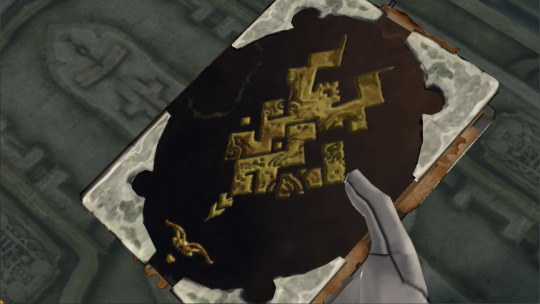
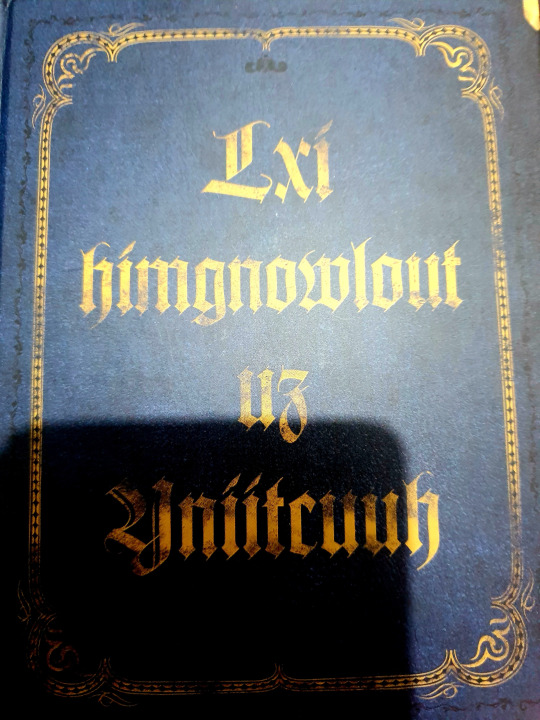

Already you can see how the historiography of Glenwood is influenced by Japanese historiography, because of the belief that has been there all along since the prehistoric times. The subjective interpretations of the situations or even origins that are not immediately knowable, especially, since both of these books are clearly written by humans (that fact isn’t hidden at all), make them feel more like they act as notes of the world, just like Kojiki and Nihon Shoki, and because of this subjective interpretation method, differences are bound to happen, even before getting to the differences of interpretations in individual readers. (By the way, the Japanese name for Celestial Record, 天遺見聞録, clearly implies this too, if translated a bit more literally, it means “the records of what is seen and heard as left behind in the Celestial.”)
Now, we get to the core of this, namely kami (神). Kami is often translated as simply “gods”, but this is, again, very misleading and not at all a good explanation of their nature. Kami, unlike the god(s) in other religions, do not come before or after the cosmos, they are the phenomena themselves and they are ubiquitous. A popular descriptor for them is “spirits or forces of nature” but even this is a simplification of what they really are. Kami describes the mind (心), an underlying principle (基本的原理), the divine to be worshipped (祭る), to be believed in (信じる), to be respected (崇める), to pray to (祈る), to be served (仕える), to be devoted (捧げる), to be given gratitude (感謝する), but most of all, kami possesses an eminent quality that is out of ordinary, that inspires the feeling of awe (畏怖) inside us all. To be in harmony with these awe-inspiring aspects of nature is to be conscious of the way of kami, and all phenomena are candidates for this designation, e.g., the sun, moon, mountains, or even great persons, heroes or leaders. However, to experience the kami presence of any one of these aspects of nature requires a pure and bright heart (清き明き心), which is an emotional, mental, and volitional condition that is not easily attained.
Here, I want to sidetrack to one of the above descriptors, that is, kami are to be worshipped (祭る). If you notice, it is the basic verb form of the word “festival” in Japanese, “祭り”. This is because one of the most crucial deeds toward kami in Japanese view is 祭る. The Japanese tend to be more religious when it comes to ceremonies than to the daily life. Worshipping kami in Japanese sense is different from other religions; whereas for some faith, the worshipping rite seems solemn and preoccupied, on the contrary, many Japanese worshipping ceremonies are very energetic and festive. Though the sacrament can be broken down into two parts: solemn ceremonial ritual and exuberant celebration, only the second part allows many people to participate more. In Zestiria, one of the biggest examples of this is the Sacred Blade Festival (聖剣祭).

But back to kami as beings. They are noble beings to be venerated, and there is a concept of Yaoyorozu no Kami (八百万の神, literally Eight-Million Kami) because there is an infinite number (eight million represents uncountable, just like how 8 as a number is often used to describe “infinity” in many cultures) and it is impossible to know them all (and it’s not like that uncountable number is static either... since humans can turn into kami and kami can inhabit any kind of object, that number naturally expands). Of course, with that many number, kami can vary from one another—they’ve been described as jinkakushin (人格神), or divine beings that have human-like qualities in that they have personalities and emotions of their own. This means that there are both benevolent kami and evil kami, so to speak. They can both bring blessings or harm to humans, and this duality means that kami are both revered and feared. Again, awe-inspiring aspects of nature. Which means Shinto as a religion isn’t exactly concerned with the afterlife like many religions, but with the nature itself, with the current life, as it is our world that is sacred. This is also true for the seraphim and the world in Zestiria.
Another term that is borrowed from Shinto is kegare (穢れ), which I usually translate to “taint” but in the context of localized Zestiria, it is known as malevolence. This, I feel, is another case of the localization causing even more misunderstanding than necessary; the kegare in Zestiria might not map 1:1 to the same concept in Shinto, but they are both fundamentally not a form of moral judgement, and whether the kegare itself is caused by a deliberate act, as for example in the case of a crime, or by an external event, such as illness or death, is secondary. As such, it is wrong to equate it to, say, Christian idea of sin, which malevolence, as a word that inherently suggests evil, kind of conveys to people. Kegare in Shinto is impermanent, as they can be remedied through purification. The concept of purity in Zestiria upholds the same quality being uphold by Shinto, namely, “真” which can be translated as “sincerity” but more literally, it means “truth.” Being true to yourself. This idea is reflected in the aforementioned “pure and bright heart” (“清き明き心”) since “pure and bright” in this case implies something that is transparent, that which is clean and clear, from the kanji themselves (to easily explain this more: 清 means “clear” and the Japanese word for transparent, for example, is 透明, which contains 明).

The Armatus (神依, kamui), as the highest power a Shepherd could have and described as the divine might (神威, which can also be read as kamui), is then, alikened to kamioroshi (神降ろし) in Shinto. Like the name implies (it literally means “descent of kami”), kamioroshi is a divine invocation held in that deity’s honor, to take possession of the one who invokes them. Since seraphim, who are based on kami, are forces of nature beyond mortal understanding, the Armatus again incites both reverence and fear of its powers.
Speaking of the seraphim being said to be beyond what humans could possibly understand, I believe this is partly why the true nature of them isn’t fully revealed. Details like how they’re born (or reborn), how they grow, what they actually are... these are meant to be mythical. We will never know, we can never know for sure. Humans tend to try to make sense of their surroundings, but there are just some things out there that will remain as mysteries to us no matter how much we try to uncover it.
(This applies as well to humans not knowing their own true nature... for example, the true nature of malevolence, said to be an irony of the contradictions of humans.)
――天族について詳しく教えてください。
山本 人から転生したという天族がいたり、いくつかの方則側はあきらかになっていますが、明確にこういう種族だよ、ということはできません。どちらかというと、神霊のような存在となっています。だから、天族たちは自分はこうなんですとか転生したんですと言っていますけど、実は何をどうしたらそうなるかという部分は非常にあいまいだったり、ケースバイケースだったりします。そういう、ルールで割り切れない部分を持った種族ですね。
――Please tell us about the seraphim.
YAMAMOTO: There are some seraphim who were reincarnated from humans, and some rules about it have been revealed, but it is not possible to say clearly what kind of race they are. If anything, they are more like divine spirits. That’s why, the seraphim are saying that they are like this or that they are reincarnated, but the truth is, the part about what to do to become like that can be very ambiguous or in a case-by-case basis. They are the kind of race that cannot be comprehended by mere rules.
――天族の成長は自身の思いにかかわってくるのですか?
山本 自分の力の強い時期まで成長するんじゃないかという推測はありますが、ここも実は法則性はないんです。
――Is the growth of seraphim related to their own thoughts?
YAMAMOTO: There is a conjecture that they will grow until they reach the peak of their own strength, but again, there are really no strict rules here.
And I understand how and why this would leave some people dissatisfied because they want to fully understand the inner workings of a fictional world to make sense of it, however at the same time, I think it’s not necessary for us to try pin down every detail to understand something holistically. Sometimes it’s fine to just feel it, to leave some things to our imagination even if it might seem hard to make sense of, but part of being humans is to appreciate beauty in these contradictions as well. Not everything has to have [human-knowable] rhyme or reason to it.
(While we’re at this, I would like to express a very subjective, very personal, and admittedly very biased opinion of mine: This is why I wish people would’ve been more appreciative of Zestiria as a standalone separate from Berseria, and not rely on Berseria to fill in the blanks of Zestiria. Berseria, to me, has a very distinct feel from Zestiria in the context of this, as the malakhim of Berseria don’t inspire the awe in me like how the seraphim are depicted in Zestiria. Everything in Zestiria that is supposed to evoke that sense of wonder, like the seraphim, Armatus, etc. is gone in Berseria, which tries to explain everything in a really mechanical, almost scientific way, and that beats the purpose of Zestiria with all its fantastical spirituality and vagueness that a lot of people hate but I personally really adore. And sometimes they can’t even do that right, as a lot of Berseria explanations directly contradict what is shown in Zestiria. This is also why I think intricate, overexplained worldbuilding is overrated; some details are better left hidden, imo. Even hidden is plain sight is better than directly explaining it to us.)
Of course, I can’t adequately explain everything that is inspired by Shinto in Zestiria, and this barely scratches the surface (and that’s not counting inspirations from other myths, religions, and philosophies like Arthurian Legend, Buddhism, Daoism, etc. that are also in the game), but I hope this can give you the rough idea! Zestiria, I feel, is a game that puts a great emphasis on the wonders of its world—it’s not that everything that we know is all there is to the world, and this world has lived for a long time, unimaginably so by humans, so there’s bound to be some things that we just don’t know, we just can’t know, but have been there all along, and you can feel them even if most of the times you can’t put it into definite words. If you think about how vast the world is, and that it keeps evolving in its vast history, some unrecorded... we become more aware and appreciative of how beautiful the world really is. And in the case of Zestiria, this is reflected in the curiosity of Sorey, the protagonist, of the world, along with its history, that opens up before him. The legends have and will always live, and someday they will become “hope.”
#tales of#tales of zestiria#mino rambles#REALLY long post#basically my zestiria lovemail#as a side note: i do think them including arthurian legend inspirations is their way to evoke similar feel to this to western people#what the devs probably don't know is that myths work and feel differently in different parts of the world#so it probably isn't effective in bringing out that sense of wonder#since hase and baba expressed concerns about not wanting zestiria to be TOO japanese#mino talks zesty
99 notes
·
View notes
Text
The Storyteller of Time in Zestiria is a person who watches over the history of the world and also passes on the truth.
(I also believe Sorey became one in the ending.)
But do you know that the Japanese term for it (刻遺の語り部) has a deeper meaning than just mere storyteller, dissecting from a Shinto perspective?
First off, let's get the first part (刻遺, which got translated as mere Time in English). I've explained this before, but the word "time" being written as "刻" has a specific connotation related to divisions of time and carries a sense of carving or engraving (for example, 刻む can also be used metaphorically to mean to engrave something deeply in one's memory or emotions), and as for 刻遺 in its entirety, it implies "abandoned in time" ("刻に遺される") or generally not affected by time = their long lifespan. They're also not allowed to directly interfere with history (time itself) and their existence is akin to a taboo, therefore basically making them forgotten by history itself despite the one being preserving it.
The Storyteller (語り部) part is actually more interesting that you might have thought, since Zestiria is very much inspired by Japanese history (I've talked a lot about this too), there actually exists a concept of kataribe (語り部) in ancient Japanese too.
In ancient Japan, kataribe serves as shokugyoubu (職業部), which were government-owned civilians belonging to the Wa royal authority (倭王権, Yamato kingship), engaging in social specialization with the special skills and techniques necessary for maintaining the kingship, however, they typically lead everyday lives as commoners, contributing periodically through labor or offering specialty products, in support of the royal authority; within the Shinabe (品部), a caste within the kingship. Kataribe's responsibility is to recite ancient traditions and present them during court ceremonies, during a time when written records, possibly using characters predating kanji (Chinese characters, which obviously were imported from China), were not well-developed too. They recite eulogies called yogoto (寿詞) during ceremonies that were associated with imperial rituals such as miare (御阿礼, advent of noblemen/kami) and minie (御贄, sacred offerings presented to kami).
One such kataribe member was Hieda-no-Are as mentioned in Kojiki (古事記, the oldest record text in Japan, I talked about it here). Interestingly, Hieda-no-Are is one of the instrumental figures of Kojiki, being that they were one of the compilers themself, yet very little was known about them, not even their exact gender, with their ancestry possibly tracing back to Ame-no-Uzume-no-Mikoto, the kami of dawn and arts. Hieda-no-Are was a Shinto priest who served the Imperial House (this kind of priest is also known as 舎人, toneri/shajin), and at the age of 28, they were entrusted with the recitation and study of texts such as the Teiki (帝紀) and Kyuuji (旧辞) due to his exceptional memory. During the reign of Emperor Genmei (元明天皇), by imperial decree, Tai-An Maro (太安万侶) recorded Hieda-no-Are's recitations, leading to the compilation of the Kojiki.
The presentation of specific kataribe activities is also found in the Engishiki (延喜式), which notes that during the Senso-Daijousai (践祚大嘗祭, the largest festival ever held in an Emperor's life, as it is the first time after ascending to the throne that the Emperor dedicates new grains to the Tenjin, including Amaterasu, and partakes in the festival by consuming the harvest, a significant ceremony occuring only once in the reign of each Emperor), the Sukune (宿禰) of Tomo-no-miyatsuko (伴造) and Saeki-no-atai (佐伯) clans led eight members from Mino (美濃), two from Tanba (丹波), two from Tango (丹後), seven from Tajima (但馬), three from Inaba (因幡), four from Izumo (出雲), and two from Awaji (淡路) (btw these are all places in old Japan) to recite ancient verses (古詞, furugoto). The content is not explicitly detailed, but it likely involved traditions and legends spanning the origin and inheritance of spirits of the past Emperors.
With the introduction of foreign religions, the traditional kataribe evolved as well, and terms such as shukugo (祝詞, liturgical prayers) were used for traditional rituals in Shinto, while those that reached the common people transformed into saibun (祭文, festival documents), shichou (詞章, poems), and katarimono (語りもの, storytelling), each with different purposes. Nowadays, in the modern Japan, kataribe basically refers to people who carry out activities to pass down the lessons of history, particularly of disasters and incidents, and I feel all this is in line with how kataribe is also like in Zestiria, and another reason why Sorey ending as a kataribe is a fitting conclusion for him--the game is about turning legends and traditions into hope (伝承はいつしか「希望」になる is the tagline after all) and that history is more than just a record of a past, but something to learn from too.
23 notes
·
View notes
Text
Sorey, Mikleo, and Growth
Mostly from the manga. It’s known that Shiramine, the author of the manga, consulted both Hase Yuuta (Zestiria game director) and Yamamoto Naoki (Zestiria game head writer), but from her tweets, we know she put her own spin as to tell another side to the story that the game couldn’t tell, that when put together (with the game as well as the novel), we could glean the message of Zestiria as a whole. (As such, I would also like to bring to your attention what the director of Zestiria attempted to achieve with the game.)

Since every panel is drawn with that thought above, I think there’s more to this too. (Using original Japanese version because the official English localization seems to translate things rather liberally, even though every word, every sentence was carefully thought up according to the author.)
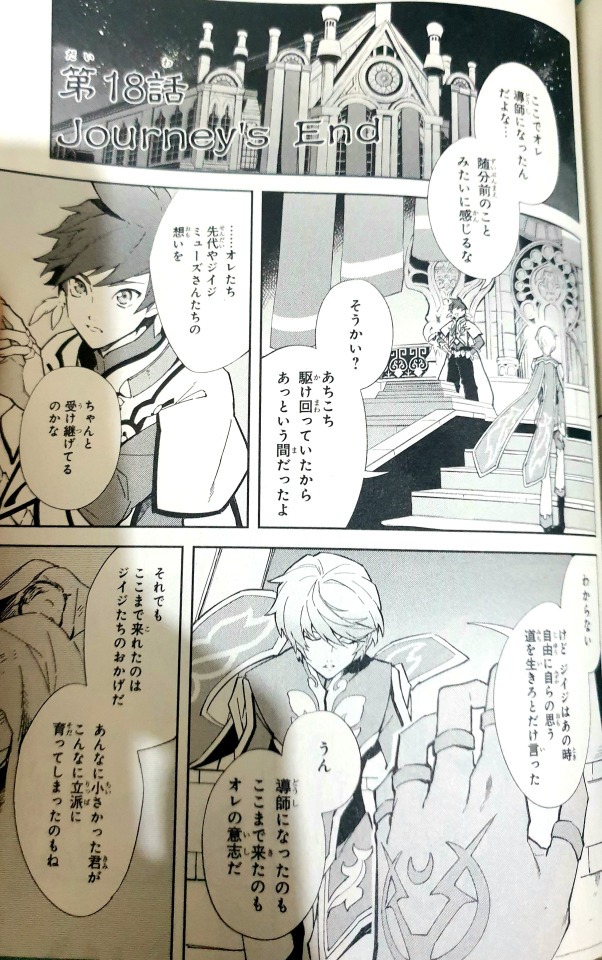
SOREY: This is where I became the Shepherd... feels like it was long time ago.
MIKLEO: Really? We were running all over the place that it all happened so fast to me.
SOREY: I wonder if we really can pass on the wishes of the previous Shepherd, Gramps, Muse, and the others...
MIKLEO: I don’t know, but all Gramps told us back then was to be free to live our lives the way we wanted to.
SOREY: Yeah, I became the Shepherd and came all the way this far because of my own will.
MIKLEO: Still though, it's thanks to Gramps and the others that we've come this far, and that you've grown up from such a small boy to such a fine man.

SOREY: You’re still growing too.
MIKLEO: I’m not talking about our heights!
In Zestiria, it is said that seraphim can control their own growth, it is different from humans in that external things affect their growth. Unlike seraphim, the way of being of humans change with time and experience (人間は天族と違い、時間・経験と共にその在り方を変えていく). Whereas seraphim can be seen as static figures that don’t change—since they’re manifestation of human’s feelings, the very bare “hearts of humans” themselves (天族とは誰かの想い、誰かの祈りから生まれた露わな<人の心>そのもの). This is why they can’t lie to themselves, nor can they taint themselves (yes, they can’t produce malevolence).
Speaking of time, it is a concept that I feel is important in Zestiria with the way it keeps being brought up again and again, and if you notice, in Japanese (in the game, in the novel, in the manga... it’s consistent), it is often written in the archaic form 刻 rather than 時, even though both are read the same way as とき. There’s a bit of nuance lost in translation here, as 刻 means “cut” in that “time” used to be represented to be cut up in old Japanese. This kind of explains what they mean by “time flowing differently for seraphim and humans” i.e the passages of time for seraphim and humans are different, measured in different units of time, so to speak.

SOREY: ...I never... want to forget this pain...
SOREY: It’s exactly because I felt pain that I was able to continue this journey.
SOREY: We're grieving, suffering because of the reality across this world... and that's why we are able to rise up for hope.
ROSE: !
SOREY: Many feelings even beyond that I had never known before were shining through! That being case, we—
MIKLEO: (Humans accept [receive] something, and with that, they change their way of being.)
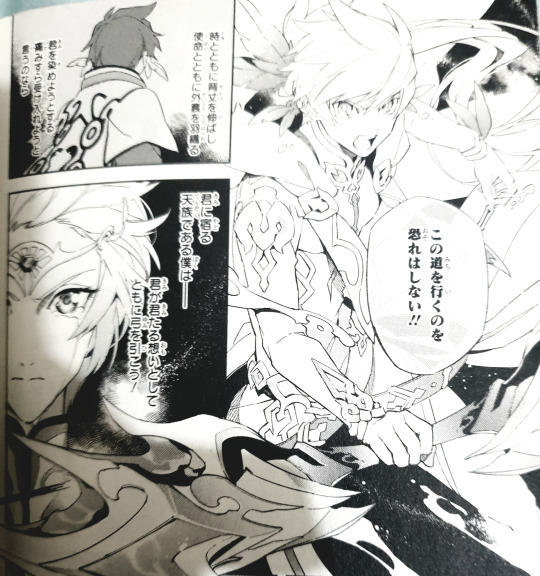
SOREY: We’re not afraid to go down this road!!
MIKLEO: (With time, you grow taller. With your calling, you don the mantle. If you, with all that, are willing to accept the pain that tries to dye you...)
MIKLEO: (Then I, the seraph that resides within you, as the thought that you are who you are, will draw the bow together with you.)
Emphasis mine. And sorry for the awkward translation, but this part is especially lost in the English translation for some reason. Here the manga focuses on the very difference of humans and seraphim—humans grow (affected by time, accepting that it changes them) while seraphim are the feelings of those humans taking form.
It’s definitely deliberate that the panel where Mikleo thinks about how Sorey has grown taller and with the Shepherd’s burden, donned the mantle, is Sorey’s back, seemingly distant, with his Shepherd’s cloak too. Ohsaka (Mikleo’s JP VA) has commented before that when Sorey pulled out the Sacred Blade and became the Shepherd, perhaps Mikleo thought that Sorey became so far out of reach for him, that at that time he probably wondered where the Sorey he knew (the childhood friend he knew) went. There’s the fact that they used to be around the same height too, until Sorey grew much taller than Mikleo was. And it was not spelled out exactly why Sorey was adamant about not making Mikleo a Sub Lord, but Mikleo in the manga understood it as Sorey not wanting the last piece of their peaceful childhood, where even the thought of becoming the Shepherd and Sub Lord didn’t cross their mind, gone.
Also, love the wording for “don the mantle”... it’s both figurative and literal, of course, meaning that with that Shepherd’s cloak he took upon the burden and responsibility himself. What’s more in JP though, 羽織る (“to put on [cloak]”) when translated very literally is “to weave feathers”, and from his feather motif (which the Taizen book has described as symbolizing Sorey being a bird who doesn’t know of malevolence taking flight off to the world) and the Elysalark skit really early in the game, it can become a very nice double meaning. I don’t even need to go to the whole “blank canvas being dyed over” imagery here that’s also in the game and even in the theme song, White Light.
Then we go to Mikleo declaring himself being the thought of Sorey being who Sorey is. Again, seraphim being the manifestation of feelings, thoughts, and prayers of humans themselves.

MIKLEO: I've been wondering about this true name that I had felt in my heart long before I even learned words. Its meaning has always felt mysterious to me...
MIKLEO: But now that I've seen that memory, I understand.
A sorrowful wish in despair gave birth to me; it is the name of that wish.
MIKLEO: It might be a curse, or fate, but we know of [comprehend in its entirety, sense, viscerally feel] the hope that resides within this vessel called life.
SOREY: ...Yeah, we can’t let everyone’s, our wishes to be tainted.
SOREY: Reach it out, Mikleo!
SOREY: Luzrov Rulay [Mikleo the Enforcer]!
So seraphim are the very hearts of humans themselves, but especially those who bear the name “Enforcer” are incarnations born as the purest form of those hearts, carrying out the will of those humans (執行者の名を持つ天族は、その心の最も純粋な形として生まれた化身), hence the name. Shiramine said that in the case of Mikleo, he was born out of Michael’s despair, which paradoxically was also his hope. Then he decided to act as Sorey’s purest will.
By the way, it’s not just manga that has Mikleo snapping Sorey out and becoming the first to offer himself as the first bullet to sever the bond between Heldalf and Maotelus. In the novel, he also offered to go first.
「この旅の終わり、僕が嚆矢となる」
“At this journey’s end, I will become the whistling arrow.”
Whistling arrows, in the Heian era, are fired before the battle not just to alert the enemy, but also friendly kami (the beings seraphim in Zestiria are based on) so that they would lend their support. Befitting of a seraph whose armatization uses a bow.
Also, take note on the Japanese quote of Aqua Limit Ultima (which kinda is horribly translated) (and also, it’s called Aqua Limit: Reunion in JP btw):
スレイ「ヘルダルフ…!蒼華たる霊霧の執行!」
ミクリオ「僕が決める!」
二人「「アクアリムス!!」」
SOREY: Heldalf...! The enforcement of the azure spiritual mist!
MIKLEO: I will end it!
BOTH: Aqua Limit!!
And that’s the will that they finally carried out. It is because they are human and seraph, that they are two people of different kinds (exactly because they’re different, not the same), each aware of their own way of being, that they can grow this far.
水魚の交わり
側に居て当たり前。互いがどんな存在か考えるまでもない。そんな関係。
Like Water and Fish
It’s only natural to be by each other’s side. They don’t even need to think what they are to each other. It’s such a relationship.
異体同心
種族は違うが、同じ想いを抱いて育った。人と天族の可能性を示す。
One Heart in Different Bodies
They are of different kinds, but they grew up embracing the same feelings. Showing the possibilities of humans and seraphim.
唯一無二の
互いに誰よりも負けたくない相手。だから成長できる。今までも、これからも。
The One and Only
They do not want to lose to each other more than anyone else. That's why they can grow. Until now, and from now on.
応えしもの
もう言葉はいらない。友の決意を心で受け止めた親友に捧げる称号。
One who Answers
No more words needed. A title granted to the best friend who has taken his friend’s decision to heart.
Truly the embodiment of what a human and a seraph can be. That’s the kind of bond that is, and the way they grow together also illustrates that.
#tales of#tales of zestiria#mino rambles#when will i be able to be more concise and coherent lmao#neverrr#mino talks zesty
83 notes
·
View notes
Text
Death as a Salvation in Zestiria
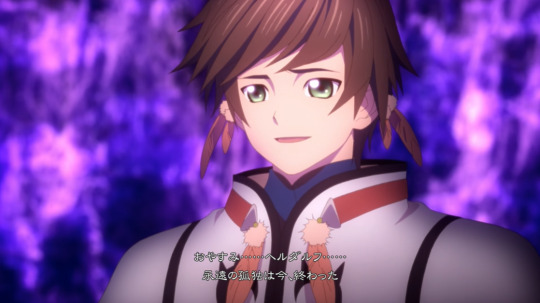
Good night, Heldalf. Your life of eternal solitude is at last over.
Zestiria, despite its medieval fantasy and Arthurian legend outward appearance, actually doesn’t hold back in its Japanese inspirations (among a lot of things, the devs have at least admitted that Sorey and Mikleo are inspired by the Japanese historical figure, Sakamoto Ryouma, and that seraphim are based on kami.)
Often overlooked, though, are its very obvious Buddhist inspirations, especially Japanese Buddhism, despite it supposedly being as apparent as the other inspirations. Perhaps viewing it through Buddhist lens would help some to understand arguably the most controversial message in Zestiria, that is, “death can be salvation.”
I will start off with a disclaimer: Even if I just say Japanese Buddhism, there are actually many schools for Buddhism even in Japan alone, so I will try to just keep things to the general stuff that is applicable in majority of the schools, or if I have to point out something specific, then I will specify which school it is from.
One thing for sure though, in whatever form it is, Japanese Buddhism has had a major influence on Japanese society and culture and remains an influential aspect to this day.
There’s a common saying that a Japanese is “born Shinto, but dies Buddhist.” In Shinto, an animistic religion, everything has a kami inside it, living or non-living. This kami that everyone has will be released at the time at death and move on. Those who pass away are highly respected, and it’s not appropriate to mourn deceased family members intensely. Death is just a reminder to push towards living more fully, meaning that it focuses more on life and is less associated with death. Buddhism, on the other hand, came to be known as the religion of funerals in Japan, and as such, it has also come to be associated with death.
This duality of a Japanese spiritual life can also be seen in Zestiria themes and messages: On one hand, you have the game celebrating how beautiful, how sacred this world, this life is. On the other hand, it also says that death can also be a release. The same duality is reflected in Sorey, the mere human with dreams to explore all the ruins, and Sorey, the Shepherd with his duty. How can he realize both of these at the same time?
By the way, Zestiria is not short on its Japanese Buddhist inspirations: you can see sokushinbutsu (即身仏) in the Trial Shrines, the Five Lords are called Godaishin (五大���), the Crucibles are named after Naraka, heck, even the original Japanese term for Shepherd, Doushi (導師), is a specific Japanese Buddhist term. Which we will get there, I promise.
But first up, I want to talk about the elements in Zestiria, our first relevant Buddhist inspiration here.

The five-element system in Zestiria is actually modeled after the same five-element system in Japanese Buddhism, known as Godai (五大), meaning the Five Great [Elements], that even the Five Lords are called Godaishin (五大神) meaning Five Great Lords in Japanese. Godai, in turn, is related to Mahābhūta, which is basically the same concept in Indian Buddhism.
This system explains that all physical aspects of existence originate from a common source and can be classified in one of the Godai manifestations of physical matter. Chi (地), or the Earth, symbolizes solid matter. Sui (水), the Water, symbolizes liquids. Ka (火), the Fire, is the symbol of combustion, or the elements in an energy-releasing state. Fuu (風), the Wind, symbolizes gases. Kuu (空), the Void, is representative of the formless subatomic energy that is the basis for the structure of all things. This Godai symbolism is also used to describe the emotional nature of human beings.
(By the way, Light and Darkness are also included in Void in this system. It is everything yet nothing at the same time.)
You can see these elements in gorintou (五輪塔), stupa used for memorial purposes.

Sometimes you can even see the Lotus Sūtra (妙法蓮華経) carved on it too.

The shapes these elements are represented by symbolize the order in which someone progresses in their spiritual journey:
The square of Earth is the basis, the will to attain perfection.
The circle of Water is the attainment of equanimity.
The triangle of Fire represents the energy created in pursuit of the truth.
The crescent of Wind represents the development of intuition and awareness.
The lotus of Void represents perfection.
However, just for one element, there are more meanings than what have been said so far, at least in Buddhism. That is, Fire, the element of the Silver Flame, as the power of the Shepherd.

For all the Shinto inspirations, it’s funny how they went with Fire instead of Water, the main element usually used for purification in Shinto (it’s not that it doesn’t use Fire either, just that the main purification ritual, misogi, uses water).
So first, I want to talk about how Shinto sees Fire. Fire seems to be viewed as the most powerful element, able to both bring something of the sacred into this world and to open the gates to the other. Izanami-no-Mikoto, the mother-kami who created the Japanese Archipelago and most of the Japanese kami, died giving birth to the Fire kami, an episode that is relevant from two perspectives: first, Izanami’s death represents in itself a myth of origin, as death did not, could not exist until it happened for the first time; second, it is fire that facilitates the transition from one level of existence to another. Izanami died, but that does not mean that she disappeared; on the contrary, she continues to exist in the world of shadows, changing her role as creator for that of destroyer, of death-bringer.
Fire is still used in Japanese rituals to establish connection between the known world, inhabited by living humans, and the world of kami and things passed. In the beginning of every year, shrines all over Japan make huge bonfires named dondoyaki (どんど焼き), where used New Year decorations and amulets are burned. At Buddhist temples, similar fires are lit for the burning of prayer tablets and amulets that had been used during the previous year. In both cases, the objects to be cremated are not viewed as no longer useful, but rather as something that has fulfilled its role on this existential level and must now ritually pass into the other, Fire being the potent element which opens the pathway.
A lot of connections to death here. But more than anything, there is a bigger symbolism for Fire in Buddhism, that is, in Ādittapariyāya Sutta, more popularly known as the Fire Sermon in English.
Sabbaṃ bhikkhave ādittaṃ
Bhikkhus, all is burning.
“All” (sabba) here refers to six internal senses (eye, ear, nose, tongue, body and mind), six external senses (visible forms, sound, smells, tastes, touches and mental objects), consciousness (viññāṇa) contingent on these senses, the contact (samphassa) of a specific sense organ (such as the ear), its sense object (sound) and sense-specific consciousness, and finally, what is subsequently felt (vedayita): pleasure (sukha), pain (dukkha), or neither (adukkhamasukhaṃ).
And by “burning” (āditta) is meant the fire of greed (rāgagginā), the fire of aversion (dosagginā), the fire of delusion (mohagginā), as well as the manifestations of suffering: birth, aging and death, sorrows, lamentations, pains, distresses and despairs.
Nibbindaṃ virajjati
virāgā vimuccati,
vimuttasmiṃ vimuttamiti ñāṇaṃ hoti,
khīṇā jāti,
vusitaṃ brahmacariyaṃ,
kataṃ karaṇīyaṃ
nāparaṃ itthattāyāti pajānātī ti.
Disenchanted, he becomes dispassionate.
Through dispassion, he is fully released.
With full release, there is the knowledge, “Fully released.”
He discerns that “Birth is ended,
the holy life fulfilled,
the task done.
There is nothing further for this world.”
This will be relevant later on, but we’ll save this for now. Just remember the three fires and suffering, “burning.”
For now, I want you to focus on the word “Shepherd”, or “Doushi” (“導師”) in Japanese. Surprisingly to me, no one has really overthought this word before, despite it being the main focus of the narrative itself. Sorey, the protagonist, is the Shepherd. And sure, I’ve said that “Shepherd” is a fine enough translation for the term, but fine enough doesn’t mean it’s the best it could’ve been, though this is a tricky one to translate because no matter what they could’ve gone with, it would’ve still been lost in translation.
See, “導師” on surface level means a guru/master (師) who guides (導), that meaning is still retained in “Shepherd”, thankfully enough. However, in Japanese Buddhism, this term has a very specific meaning, and no, it’s not just “monk.”
It’s specifically a monk who facilitates funerals.
Originally, Doushi is just a monk who gives Buddhist sermons, who guides people to the path of Buddha, however, it has specifically come to mean a monk who gives indou (引導), which, to put simply, is a requiem of the dead, meant to lead/guide the dead to Nirvana, enlightenment; by having the Doushi recite the Dharma (“cosmic law and order”, Buddha’s teaching) to them. Aside from that, they’re also in charge of makuragyou (枕経), literally pillow sutra, which is the sutra recitation at the bedside of a deceased person.

So with this, I want to remind you that Sorey has a title, Vigil-Keeper (看取りし人), that basically means someone who attends to death. Someone who watches over someone else on their deathbed. And I’ve talked about that too here.
Back to Fire, the element, there’s an interesting expression in Japanese that basically is a euphemism for dying, which is “命の火が消える”, literally meaning “the fire of life is extinguished.” In the novel, among the many deaths, this expression is only used twice to describe death.
The first time, it’s Mikleo’s death as a human.
だが、生まれたばかりで柔らかかった皮膚はいま、熱と炎でただれ、命の火を消えそうとしている。
But the newborn’s tender skin was now inflamed with heat and flames, and his fire of life was about to be extinguished.
The second time, it’s Heldalf’s, as killed [saved] by Sorey.
And we know Mikleo immediately got reborn as a seraph afterwards, a being described as the purest, the noblest being ever. Seraphim are also beings that don't experience external change, unlike humans (人間は天族と違い、時間・経験と共にその在り方を変えていく), meanwhile life is full of changes according to Buddhism.
「おやすみ、ヘルダルフ……永遠の孤独はいま、終わった」
「………気に入らん……な……最後まで抗おうと……いう……のか……」
ヘルダルフの口がさらに何かを紡ごうとしていたが、もはや言葉にならず、彼は命の火を消した。
“Good night, Heldalf. Your life of eternal solitude is at last over.”
“You dare fight back even until... until the very end. I can't... I can't stand it.”
Heldalf’s mouth was trying to spin something more, but words could no longer come out, and his fire of life extinguished.
I want to note here that “命の火を消した” is more “extinguished his fire of life” but I didn’t want to make it sound like Heldalf, himself, did it, since Sorey was the one who did it. Wording, deliberate, Zestiria is all about reading between the lines after all.
But why? You might ask.
Remember how I said the Buddhist Doushi’s job is to lead the dead to the Nirvana? Nirvana (涅槃), the Buddhist salvation, as a word often gets translated as “enlightenment”, as “liberation” from suffering, but at the base level, it has another meaning. Or two, even.
One, “extinguishing of a flame.” Two, “death.”
Nirvana is the extinction of the “three fires”, namely of greed (raga), aversion or hate (dvesha) and of delusion or ignorance (moha or avidyā), the same three fires as before. This signifies the permanent cessation of saṃsāra (meaning “wandering” but basically is the “karmic cyclicality of all life, matter, existence”) and rebirth. Attainment of salvation or Nirvana is main goal of Buddhism.
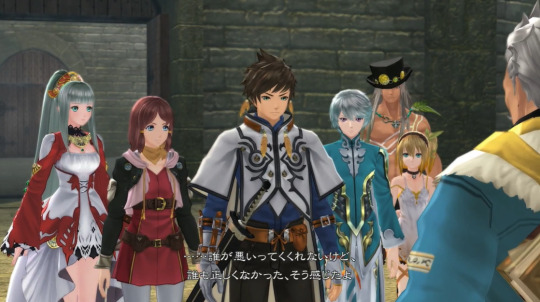

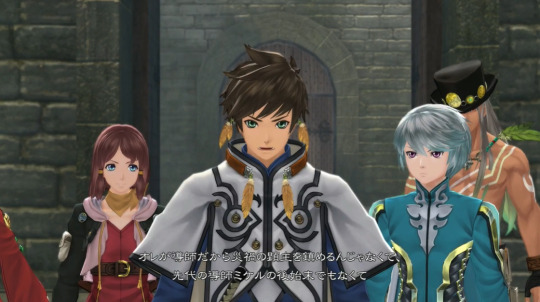
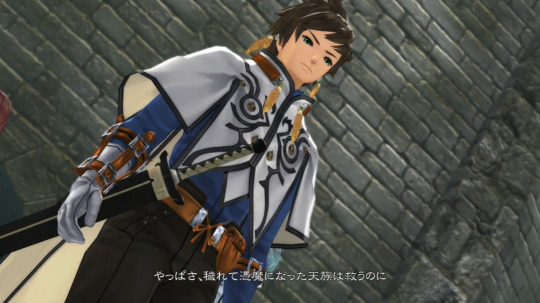
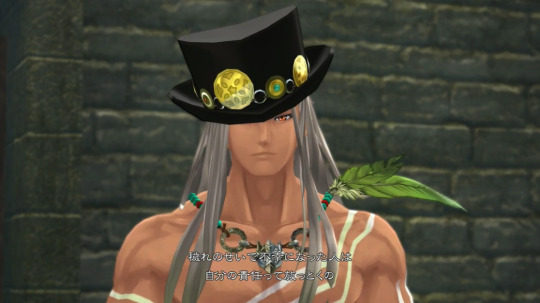
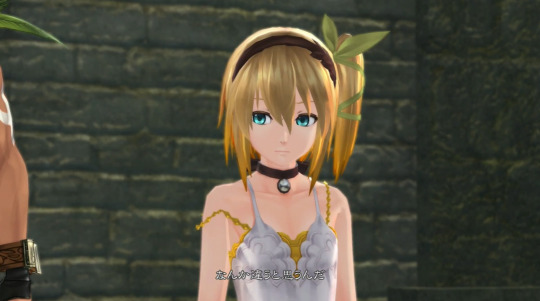







SOREY: No one involved was fully in the wrong, but no one was really right either. That’s how it felt to me.
SOREY: My answer... is I want to save Heldalf.
SOREY: The Shepherd’s job doesn't just boil down to “quell the Lord of Calamity,” or even “clean up the previous Shepherd’s mistakes.”
SOREY: When malevolence consumes seraphim and turns them into hellions, we save them...
SOREY: ...Yet when it brings misfortune and grief to humans, we say they only have themselves to blame.
SOREY: It doesn’t seem fair.
MIKLEO: There are humans out there just like Heldalf.
MIKLEO: He just happened to play one part in a cascade of terrible events.
ROSE: I’m not gonna say you shouldn’t sympathize with him.
ROSE: But I will say it would strike me as bizarre to completely let him off the hook for the horrors he brought to such a peaceful village...
ROSE: And what he’s trying to do now is still messed up... Right?
SOREY: Absolutely. It’s wrong, period, and I will stop it.
SOREY: If I won’t save humans like Heldalf who’ve had hellionhood thrust upon them, I’ll never see humans and seraphim live in peace!
In Shingon Buddhism, Fudou Myouou (不動明王), of the Vidyārāja, is assigned as the Doushi to the first seven days of service when mourning, as he tops the list of Thirteen Buddhas. Fudou Myouou is the manifestation of Dainichi Nyorai (大日如来) in disguise, always close at hand to protect us. He resides within the hearts of those who believe in him, protecting them and providing them with blessings.
If he were an animal, he would be a dragon; if he were an object, a double-edged sword; and if he were a color, gold or blue-black.
Fudou Myouou holds a sword in his right hand, the sword with the dragon king Kurikara (倶利伽羅), which represents righteous Buddhist wisdom to cut off evil thoughts and doubts. The rope in his left hand is meant to bind bad minds and awaken good minds. The flame on the back is called Karura-En (迦楼羅炎); Karura or Garuda is the name of a legendary bird that eats poisonous animals. The flame in the form of this bird represents the consuming of poisonous things. The rock beneath his feet is called Banjaku (盤石), a large, hard rock. It represents a stable mind without hesitation. The sutra says “sitting on a vajra stone” (“金剛石に座し”) which means sitting on a huge diamond.
More than anything else, though, Fudou Myouou takes on a wrathful form in order to save by force even the most irredeemable sentient beings who are afflicted with kleshas.
(There’s also an idea of akunin-shouki [悪人正機] in Joudo Buddhism:)
善人なおもって往生を遂ぐ、いわんや悪人をや。
Even good people can be saved, so let alone the evil people.
(Wind back the clock to the 12th century in Japan, which was an age of devastating social unrest. The vast majority of people—poor peasants, socially disadvantaged and discriminated—were losing homes and loved ones due to never-ending civil wars and starvation, feeling abandoned and helpless. But Buddhism wasn’t available to heal them because, at that time, it was only a religion for the social elites and intellectuals. For those who are good people already. This conundrum caused anguish for some monks: Why couldn’t Buddhist society do anything to help people who were in dire need of Buddha’s mercy [who needed it the most]? It’s against our core creed, which is “each and every one is saved.”)
(Eventually, a few monks decided to give up their status in the mainstream of Buddhism for good, and founded new schools in order to help the suffering people. Among them were Hounen and his disciple Shinran. They advocated akunin-shouki, and addressed it directly to desperate people: “I know you have been belittled, bullied, and given no opportunities nor any access to things that could help improve your lives. Not only have you never learned how to pray, but you might have had to do bad things in order to survive. I feel your pain and sorrow, but I want you to know that you are already forgiven, embraced and celebrated by Buddha’s mercy, exactly because of your helplessness and ignorance. Embrace your insignificant self. All you have to do is to chant the prayer, and you are saved. Buddha is always with you.”)
(These are the “bad people [those who do not know how or did not want to become a better, good person to achieve religious goals] are saved” as part of akunin-shouki. It was enthusiastically welcomed by the “bad” people—the illiterate, ignorant, poor and disadvantaged—who were never recognized nor approved of by society, let alone embraced and celebrated. They were overjoyed to discover that all they had to do was to chant nenbutsu “I take refuge in Buddha”–which could be done even if you couldn’t read–and they were saved. Buddhism finally became a people’s religion.)
Because in Buddhism, there are no sins, as there is no judging god out there that would punish you for your sins.
What there is though, is karma, the “law of cause and effect.” But karma is not punishment, not reward. Think of karma as a natural law, like gravity. You don’t need anyone to administer the law of gravity. Any time you are not careful you may fall and hurt yourself and experience suffering, but it is not a punishment for your lack of attention. You can also use gravity to generate hydroelectric power at a dam.
The same way that gravity doesn’t have morals attached, doesn’t need to be administer by a mighty god and can produce suffering in some cases and happiness in other, karma doesn’t have morals attached, doesn’t need to be administer by a mighty god and can produce suffering in some cases and happiness in other.
Karma tells you that there are some acts that produce suffering for you or others and, that there are acts that produce happiness for you and others.
If you avoid the former and stick to the later, you will be happier.
...
With all of this said and done, I would like to end it by saying that not everything has to be taken at surface level, taken so literally. Shepherd, hellion, death, salvation... everything here is just a symbol. It’s a fictional work, it can afford to do things like this, through symbols, images, patterns, ideas, metaphors that we recognize. Because they keep coming up, and they're entrenched in our subconscious through that repetition. I want people to step back and look at this at the bigger picture, and try to glean what the message really is, instead of being caught up in the unnecessary details.
I hope this has been insightful.
57 notes
·
View notes
Text


Which of Sorey and Mikleo's exchanges leave the most impression on you?
KIMURA (SOREY): The fact that they fight too. That left an impression on me.
OHSAKA (MIKLEO): Like at the Aqueduct ruins right.
KIMURA: Yes, that! It's still the beginning of the game during that part, they're both still young too, so it wouldn't be strange for them to get into a fight. Sorey is generally mild-mannered towards people, though of course, he can get angry when necessary, but that wasn't the case here. They truly had a childish argument and ended up being apart, but they both each other knew what would happen next. I was deeply impressed by the strong bond between them, where their argument was because they cared about each other. They really did end up fighting out of their concern for each other, these two are really amazing.
OHSAKA: In the end, even though what they do may differ, they're looking at the same thing. It's like, even before the final battle, [Mikleo] doesn't say much because he knows everything about [Sorey] already. That's how they both are. Even though it might be short in time, they share many experiences during their journey, getting to know each other even more, and finally, they don't need to say anything to understand each other. I could feel that kind of bond with tacit understanding between them and it realy left an impression on me, it made me think "yeah, that's how they are."
10 notes
·
View notes
Text
Sorey, the Vigil-Keeper


I know there’s a popular theory that Sorey might be reborn as a seraph at the ending, but to this, I would like to propose an alternative that is not less convincing, with hints spread throughout both Zestiria and Berseria.
スレイ「……オレ、メーヴィンに教えて貰ったこと絶対忘れない。ずっと伝えていく!」
メーヴィン「……ふ。俺が看取られるなんて……考えた事も……なかった」
In this dialogue from the screenshots above, I want you to pay attention to the word “看取る” and its variations, as it is a word that keeps coming up in the story.
If you look up in dictionaries, you would find that the Japanese word “看取る” means “to attend someone’s deathbed; to care for someone who is close to death until their death.” It is, admittedly, a word that is hard to translate to English.
Here’s how the official English translation goes about, emphasis mine, to bring attention to how it’s localized:
SOREY: I promise... I'll never forget what you've told me, Mayvin. And I'll teach it to others as well!
MAYVIN: Heh. Never did I imagine I would die with others... By my... Side...
But I think the word has significance in Zestiria lore, with Mayvin, being one himself, didn’t expect to have someone to watch over him as he died.
And how do I know that? It’s in the name, as explained in the sidequest revolving the poet Mayvin.


Here’s a bit of the dialogue as a refresher, with omissions here and there:
アカシャ「語り部は個の名を持たない一族。『メーヴィン』とは一族が代々受け継ぐ名なのです」
ミクリオ「つまり、詩人は何代前のメーヴィンか!」
ザビーダ「メーヴィン……『看取る者』って意味だっけか?」
アカシャ「彼らは、その名と共に契約を受け継ぎ、世界を傍観する宿命を負うのです」
ミクリオ「しかし、なぜそんな宿命を?」
ザビーダ「初代がなんかやらかしちまって、強制的に誓約が与えられた……とかなんとかだっけ?」
スレイ「応えなきゃな。メーヴィンが託してくれた想いに」
Here is how it goes in the official English localization (emphasis, again, mine):
AKSHA: Those in the clan of Storytellers have no names of their own. The name “Mayvin” is passed down through the generations.
MIKLEO: So the poet Mayvin was his ancestor from centuries ago!
ZAVEID: Doesn’t “Mayvin” mean “Caregiver” in the old tongue?
AKSHA: Those born into that name and that oath must accept their fate to be observers of the world.
MIKLEO: But I wonder... why is that their fate?
ZAVEID: Wasn’t it, like, the first one did some damn fool thing and wound up forced to take the oath as punishment or something?
SOREY: We need to work hard to live up to the hopes that Mayvin placed in us.
But if I were to translate it myself more closely to the original Japanese, it would be more like this:
AKSHA: Those in the clan of Storytellers have no names of their own. The name “Mayvin” is passed down through the generations.
MIKLEO: So the poet Mayvin was from several generations ago!
ZAVEID: Doesn’t “Mayvin” mean “Vigil-Keeper” in the old tongue?
AKSHA: Those inheriting that name and that oath must accept their fate to be observers of the world.
MIKLEO: But I wonder... why is that their fate?
ZAVEID: Wasn’t it, like, the first one did some damn fool thing and wound up forced to take the oath as punishment or something?
SOREY: We need to work hard to live up to the hopes that Mayvin placed in us.
What am I implying here? I think that the Storytellers of Time, as a clan, don’t have to be related by blood. The wording used here to me implies that the name is inherited, passed down. (Fits nicely with Zestiria’s theme that “Legend will someday become hope.” Legends or “伝承” are things that get passed down. That get inherited. That outlives its keepers, because it is the hope or will that will not die as long as there’s someone out there to accept it.)
It’s a name that means 看取る者, the one who attends someone on their deathbed. As for why I translated this as “Vigil-Keeper”, I will bring it up later.
(As a sidenote: Sorey gets his alternative costume from this sidequest. Makes you think.)
But first. Let’s talk about Mayvin more. After all, there’s also “Mayvin” in Berseria.


マギルゥ「メルキオル・メーヴィン、火山で待っておれ」
マギルゥ「案ずるな。お主の最期は儂が”看取る”」
MAGILOU: Melchior Mayvin, I’ll see you at the volcano.
MAGILOU: Don’t you worry. I’ll be sure to be there as you breathe your last.
Hard, isn’t it, to get this point across in English? But they actually put the word in the quotes as ”看取る” as if trying to get your focus on that word. Part of why I think the name “Mayvin” (along with the oath that comes with it) gets inherited as you watch someone die before your eyes, and take on their name.
Now back to Zestiria. Sorey actually has a title series that corresponds to the turning points of his character development, namely:
Lad of Separation (別離の若者) (Bronze): Obtained when he left Elysia, as he learned the lesson of farewells.
Reunited Traveler (旅は道連れ) (Silver): Obtained when Rose joined the party, as he learned to be with a human companion that can understand him as a fellow human.
Vigil-Keeper (看取りし人) (Gold): Obtained as he watched Mayvin die in his arms. I will explain more on this below.

看取りし人
消えゆく命を見届け、その想いを胸に刻んだ者に託された称号。
Vigil-Keeper
A title entrusted to one who sees off passing lives, and engraves the wishes of the fallen upon his heart.
(By the way, it’s also part of a series of titles belonging to the seraphim too.)
Yes, it’s the same word/characters you see in all of the previous ones shown above. He actually obtained a title that is basically the ancient tongue meaning for “Mayvin.”
刻遺の語り部
「メーヴィン」という名を代々受け継ぐ人間の一族がいる。彼らは「刻遺の語り部」と呼ばれる存在で、「人間・天族・導師・憑魔などの歴史に干渉しない」という誓約により、非常な長命を得ている。「刻(とき)に遺される」という名からわかるように、人間では考えられないような時間を生きながら、人や天族が織りなす歴史を語り、後世に残すことを使命としている。これは初代メーヴィンに対して課せられた、一種の義務や罰ではないか、という説が伝わっている。歴史に干渉しないためその存在を知る者は少なく、天族のあいだでも語ることは禁忌とされているようだ。
Storytellers of Time
There is a human clan which inherits the name “Mayvin” from generation to generation. They are known as the “Storytellers of Time” and have a very long life due to their oath not to interfere with the history of humans, seraphim, Shepherds, and hellions. As implied from the name “abandoned in time,” they have the duty to tell the history as woven by humans and seraphim while living for a long time unimaginable for humans, preserving for the future generations, left behind by the world and time. It has been theorized that this may have been some kind of obligation or punishment imposed on the first Mayvin. Since they do not interfere with history, few humans know of their existence, and it has become something of a taboo to talk about, even among the seraphim.
As a note, the “Time” part of the title is “刻遺” and I believe I had already talked about the word “time” being written as “刻” before. It also implies “abandoned in time” (“刻に遺される”).

ミクリオ「マオテラスと繋がり、刻にとり残され、何年……いや、何百年待つのか……」
MIKLEO: By bonding with Maotelus, you’ll be abandoned in time. It could take years… It could take centuries.
Interesting wording, is it not?
By the way, another interesting but easy-to-miss detail:
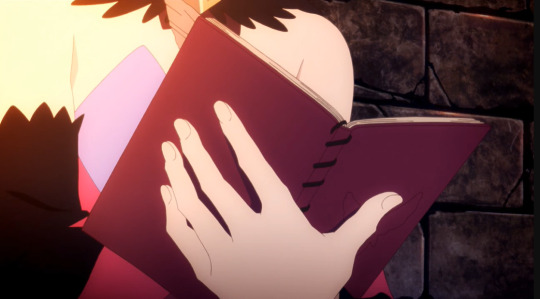
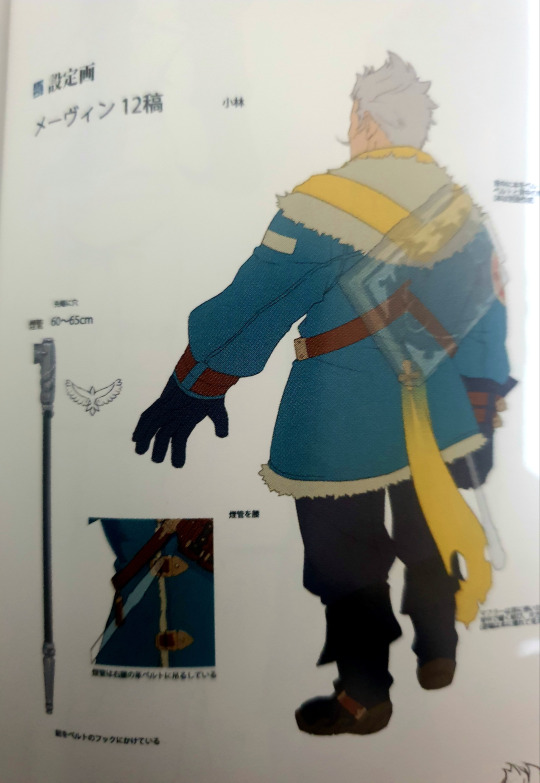
If you squint closely, both Magilou and Zestiria!Mayvin have bird motifs (on her notebook for Magilou, where presumably she wrote the stories to tell to the next generations, and on both his pipe and book for Z!Mayvin). You know who else has bird motifs?

空に飛び立って
幼い頃からいつも身に着けている羽の耳飾り。穢れを知らない鳥は故郷を飛び立ち広い世界を目指す。
Flying into the sky
A feather earring that he has always worn since he was a child. The bird, knowing nothing of malevolence, takes a flight off from its homeland to the vast world.
(I mean, a lot of Zestiria and Berseria characters have bird motifs, but hey. And I will someday talk about this too, but we’ll save this for the future.)
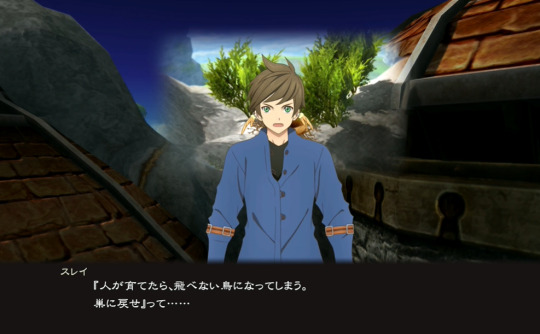

スレイ「『人が育てたら、飛べない鳥になってしまう。巣に戻せ』って……」
スレイ「あいつ……無事に巣立てたんだな」
SOREY: “A kept bird will never learn to fly,” he said. “Put it back.”
SOREY: Guess you made it out of the nest on your own, huh?
And I love it. I love this because at its core, Zestiria is about humans and seraphim, and Sorey and Mikleo are intended by the creators to symbolize that. Being a storyteller and explorer fits him as his defining character trait is that he is passionate about history, passionate about finding ways on how to unite humans and seraphim. Sure, he was still the Shepherd up until before he brought out that second strike to Heldalf, and ended his suffering of Eternal Solitude, but right after that? Right after all this is done? I’m inclined to believe he might take the oath, take the name “Mayvin” after the one human he learned from the most.
But I don’t think he is going to see it as a burden, an obligation, a punishment... after all, the essence of adventure lies in exploration, in the words of Mayvin, the Explorer.
And, in the words of Mayvin, the Storyteller, you can’t fathom the true meaning of legends until you’ve seen their history with your own eyes...
(He might not be able to interfere with the world history after this, sure, but in a way, that also frees him from the shackles that used to bind him as the Shepherd. He had done what he needed to. Now is the time to entrust it to the next generations.)
ところで『探検家』であるために一番大切なことはなんだと思う?
好奇心や勇気も重要だが、一番じゃないな
答えは『探検から無事に帰ること』だ
By the way, what would you say is the most important quality of an explorer?
Curiosity and courage are definitely key, but they are not the most vital.
The answer is the wherewithal to come back from your exploration safely.
And he did come home safely. At the end.
#tales of#tales of zestiria#mino rambles#as a warning: wall of text#and even more importantly#a lot of pics lol#btw i still think both interpretations are valid re: sorey in the ending#it's why they left it vague too i think#yamamoto: we'll leave what happens after the ending to players' imagination after all#mino talks zesty
57 notes
·
View notes
Text
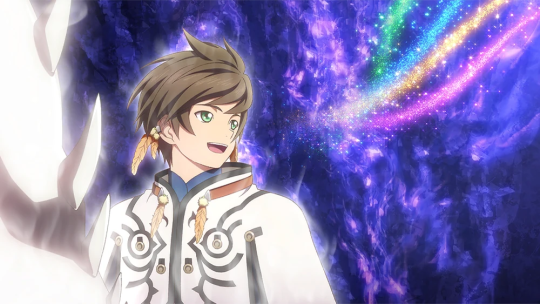
I love Sorey’s ending MA in Rays, Raijin Souhyoujin (雷迅創���刃).
It is an Ice- and Lightning-elemental MA, the elements reflecting his connection to Mikleo and Gramps respectively. He’s really an Elysian through and through, in the end, going back to his origin (historical technicalities would make his hometown Camlann, but that’s just historical technicalities; his heart belongs to Elysia forever.)
Also love how they went for “雹” instead of plain “氷” for the “ひょう” part of the name. “雹” or “hail” in English, is a type of precipitation (condensation of water vapor) that usually gets formed during thunderstorms. Again, you could see the connection to his Elysian family.
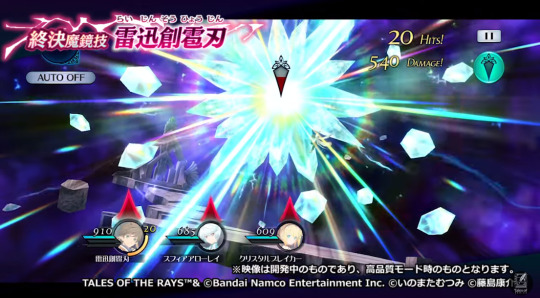
雷を呼び、限界を超える全身全霊の一撃を放つ魔鏡技。
A mirrage arte that calls forth lightning and unleashes a blow of one’s whole body and soul transcending the limits.
Again with the 全身全霊/whole body and soul, but this time transcending even the limits. He even says it in the quote.
来たれ神雷!オレの全てで!限界を超える!
Come forth, divine thunder! With my everything! I will transcend the limits!
Popular theory has it that Sorey might be Heldalf’s biological son (there are more than just that one manga page supporting this theory, btw, hints were even in the game itself, but we’re not getting into this today) and in a way, he inherited Lion’s Howl (獅子戦吼) from him, so now even beyond that, he inherits one from his actual parent, the only one that matters to him.
I know Sorey being mostly associated with the Lightning element is not a new thing; after all, both his MAs in the original game, Bolt Tempest (雷迅双豹牙) and Divine Wrath (烈震神雷牙), are for all intent and purposes Lightning-elemental anyway, they’re only Void in the game because it’s Zestiria that classifies Lightning/Light and Dark under Void... but here are some other fun stuff while we’re at it:
Kimura Ryouhei (Sorey’s JP VA) suddenly tweeting Indignation chant, which made Indignation trended on Twitter on that day too. In Tales of Memoria, years before this tweet was even made, Tales-related questions were asked to the VAs, and one of the questions was what arte they would want to use, and Kimura answered Indignation to that.
Speaking of Indignation... I’ve always wondered why Sorey’s profile in Perfect Guide has Maotelus’ crest instead of the usual Shepherd’s dragon’s crest.
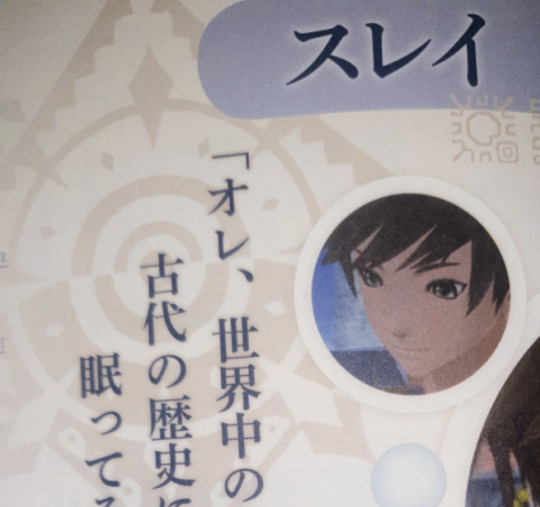
In the official Chinese localization of the game, Sorey’s name is rendered 史雷, very fitting for him since it consists of the characters for “history” and “lightning” and I will always love his Chinese name for this... really unintended meaningful name.
So yeah, Lightning child Sorey. As far as Sorey is concerned, Zenrus is his parent, the one who could give him more than enough love that he couldn’t get from the father and mother he’d never had.
44 notes
·
View notes
Text
Water Armatus, Bow and Arrow

I’ve always thought that it is interesting that the Water Armatus wields bow and arrow, especially since it holds many significances in the Japanese culture that Zestiria draws many inspirations from. I believe it’s a deliberate choice that the Divine Artifact needed for Water Armatus is a bow too, so I will try to elaborate more on this, since the many meanings for it might not be apparent to people who aren’t familiar with it.
Remember: Symbols can have more than just one meaning.
First off, and I know we start with the ending part here, but since it’s actually stated in the novel, I will talk about how Mikleo offers to go first, as the whistling arrow (嚆矢). Our first symbolism, but far from the last, for the Water Armatus.
「スレイ、最初に僕を撃ち出せ」
「ミクリオ……!」
息を飲むスレイをミクリオは決意に満ちた瞳で見つめる。
最初に撃ち出す仲間を迷うであろうスレイの気持ちをくみ取った提案だった。
「この旅の終わり、僕が嚆矢となる」
僕たちの決意と覚悟を最初に撃て。
“Sorey, shoot me out first.”
“Mikleo...!”
Mikleo looks at Sorey, who gulped, intently with eyes full of his determination. It was a suggestion that took into consideration the feelings of Sorey, who had been hesitating about which friend he would shoot out first.
“At this journey’s end, I will become the whistling arrow.”
Shoot our determination and resolve first.
The whistling arrow (嚆矢) often symbolizes “dawn” or “beginning”, since it’s used to signal the beginning of battle. Particularly, around the time of Heian period, an arrow with a whistle (kabura, 鏑) attached (so often known as kabura-ya, 鏑矢 as well) would be shot, not only to alert the enemy, but also to ward off evil spirits and alert friendly kami to lend their support through its whistling sound. Befitting for the seraph whose Divine Artifact is a bow, since he does this to reassure Sorey, as well as to ask for support for him from the friendly kami—other seraphim that will come after him. Mikleo is also the one seraph who has been with Sorey since the beginning too, even before Sorey became the Shepherd. Since the dawn of the Shepherd (導師の夜明け).
(An arrow that flies straight and steadfast signifies no hesitation for its resolve.)

But bows and arrows mean so much more than this, so I would like to take a look at other meanings too, as well as going earlier than straight-up the final battle. The first obvious thing that stood out to me is that in Japanese, bow and arrow (弓矢, yumiya) is often a symbol for the battlefield, since 戦 (read as ikusa), meaning war or battle, used to be written as 射交矢 (also read as ikusa), roughly meaning exchanging arrows (射交わす矢). Hachiman (八幡神), the Shinto-Buddhism syncretic divinity of archery and war, is also known as Yumiya Hachiman (弓矢八幡), because his messenger is a dove that symbolizes bow and arrow. Hachiman’s wife, Himegami (比売神), often refers to Munakata Sanjoshin (宗像三女神), the three matriach kami associated with water born from the ukehi or oath (宇気比, 誓約) between Amaterasu and Susanoo (I will talk more about this when I talk about Mikleo’s association with water divinities in Japan, since it can get even more interesting if you dive deep and go down this rabbit hole, and I tend to overthink this kind of stuff anyway).
However, going back to a time even older, the ancient times, bow and arrow used to be written as 箭霊 (read as sachi), with 箭 being the outdated kanji for arrow and 霊 being the kanji for spirits, representing 霊威 or mysterious power. The word 箭霊 (sachi) here has the same reading as 幸 (sachi) meaning happiness, thus bow and arrow are also associated with happiness and blessings. As such, in Japan, where the animism of primitive religion remains strong, the bow and arrow is also a tool for divination of good fortune. In terms of shamanism/sorcery (呪術, jujutsu), often it is also called 天之返矢 (ama-no-kaeshiya, Divine Returning-Arrow), and this word comes from the myth in Kojiki, where a bird named Nakime (鳴女) who was sent down to earth to check in on Amewakahiko (天稚彦 or 天若日子). Amewakahiko shot the bird with his bow. The arrow pierced through the bird, but the arrow flew all the way to heaven. Takamimusubi (高御産巣日神) saw the arrow and threw it back at the earth where it hit Amewakahiko while he was laying in bed, killing him.
There are also Narugen (鳴弦), which is used like a weapon or musical instrument to exorcise invisible demons and evil spirits, and Hama-ya and Hama-yumi (破魔矢・破魔弓), symbols of the bow and arrow’s magical power, as seen in myths and legends.
Hama-ya, in general, has come to mean ceremonial arrow to ward off evil. In Buddhism, there is a legend that the gold bow and arrow held by Umarokya (烏摩勒伽), one of the four yaksha who follow Shoumen Kongou (青面金剛), the blue-faced Vajra, is the origin of the Hama-ya, and Ryuujin Hamaya (龍神破魔矢), the dragon deity, is named after it. The tip of hama-ya needs not to be sharp, since it is used to purify, as to remove the obstacles, not to target and break the person themself.
(I’d like to also remind that the seraphim are based upon Four Symbols, and Mikleo is based on the Azure Dragon. This can even be seen in the Water Armatus’ Banish Blast, 水神・清龍, which can literally be translated to Water Divine: Azure Dragon.)




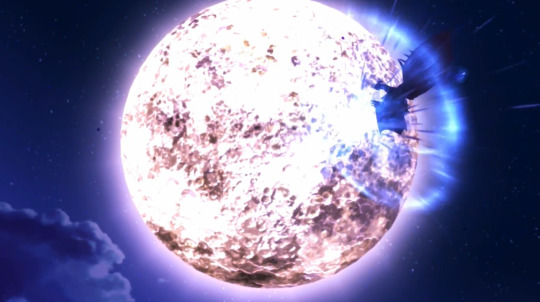
There is this one story, the tale of extermination of Nue (鵺)—a Japanese mythical creature with a monkey’s head, tanuki’s body, tiger’s limbs, and a snake tail—in “Heike Monogatari” (平家物語) where the Emperor was afflicted with an illness, but when Minamoto no Yoshiie (源義家) plucked the bowstring three times, the evil spirit was dispelled and the Emperor was restored to health. However, the source of the disease itself was not dead and continued to threaten the Emperor. Minamoto no Yorimasa (源頼政), then, climbed to the rooftop of the Imperial Palace at night and shot an arrow, and in just that one shot, slaying the source of the disease, a monster called Nue, with Yumiharidzuki (弓張月, representing the bow or the Moon, the crescent moon that looks like a bow).
And thus, the bow and arrow is associated with purification or exorcism (祓い清め) of the mind (心) from taint (穢れ), malice (邪気), evil (魔), and disaster (厄), as seen in a lot of metaphors in Japanese. The pure-hearted is said to be able to immediately hit the bull in one hit. The arrow of the noble is destined to strike the enemy and hunt the beast of fables.
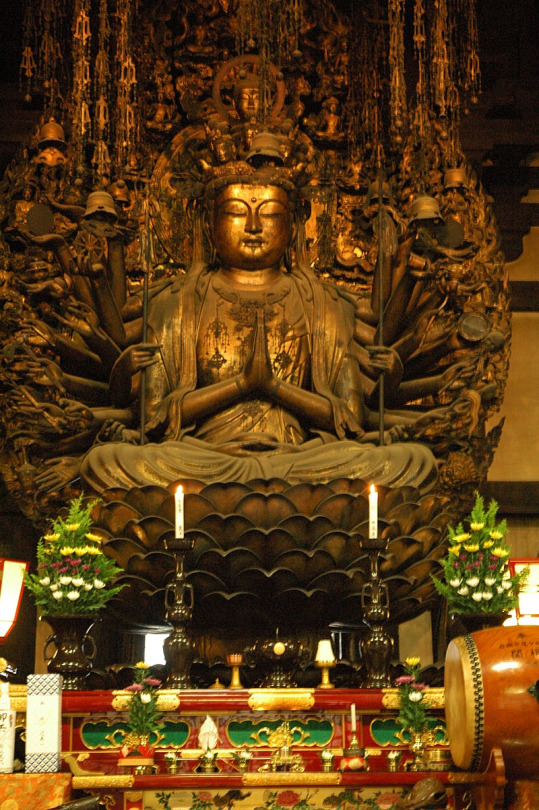
Now we turn to Buddhism. Senju Kannon (千手観音) or Senju-Sengen Kanzeon Bosatsu (千手千眼観世音菩薩), the bodhisattva of compassion and mercy, is perhaps the most widely worshipped bodhisattva in Japan. Senju-Sengen (千手千眼) literally means Thousand Arms and Thousand Eyes, originating from the fact that she has one eye in each palm of a thousand arms. These thousand arms and thousand eyes represent Kannon’s vastness of mercy and the abundance of means to save, as endeavors to relieve every living thing. In her many hands, she holds many objects, and each of these objects varies in meaning.
Two of them are houkyuu (宝弓) and houzen (宝箭), a bow and an arrow, respectively. Houkyuu stands for “increasing the honor” (“栄官を増す”), but more relevant is the meaning of houzen, which is “chance meeting with good friends” (“良き友に巡り会う”). A poetic way of saying reconnecting with true friends.


The final version of Aqua Limit, Aqua Limit: Ultima, is actually called アクアリムス・リユニオン, or Aqua Limit: Reunion, in Japanese. This indeed foreshadows their reunion in the epilogue, that they will meet again, and it is by chance (through a connection that ties them, that cannot be seen, yet can be felt, or it is precisely because it’s not seen that it can be felt stronger). Neither knew how long it would take, perhaps it would take centuries, but they could finally get there, reuniting with each other, in the end. Reunion of true friends. Mikleo, the bullet, the whistling arrow, is that connection with true friends that will never fade way, even as he is shot to the risk of his death in the final battle, and after this, Sorey will go to sleep to purify Maotelus for who knows how long. Eons, perhaps.
(Mikleo himself doesn’t consider himself as Sorey’s true friend, since he thinks that as a seraph, he can’t perceive the world the same way as Sorey does. It’s why he invited Rose to join the party. But true friends complement each other, just like how Sorey and Rose have different approaches [sees in different ways], Sorey and Mikleo complement each other through their differences.)
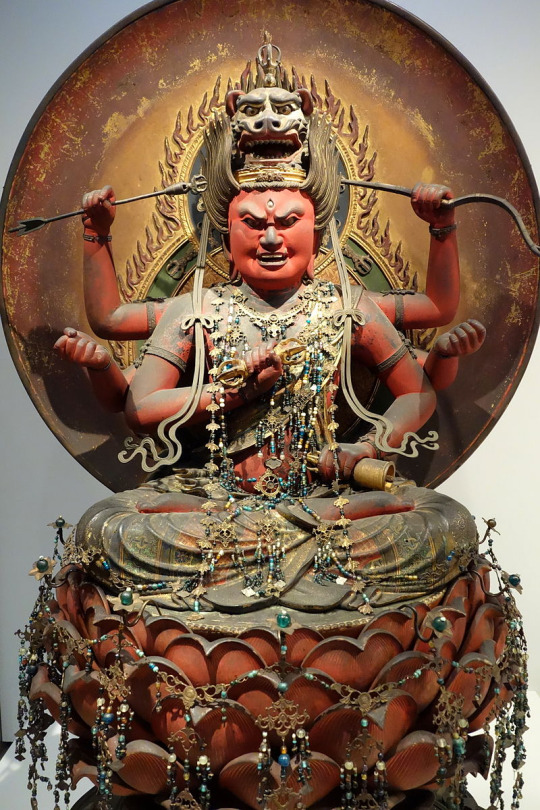
In Buddhism (especially Shingon Buddhism), there is a deity that is often associated with bow and arrow, Aizen Myouou (愛染明王). He has a very distinctive appearance, wearing a shishi (獅子, magical lion)’s crown on his head and sitting on a lotus flower. Sometimes, he is depicted with two heads: of his own and of Fudou Myouou (不動明王, and I believe I’ve talked about Sorey being a Fudou Myouou figure here), symbolizing a commingling of subjugated, complementary energies, and in Japan, they are both enshrined together, Fudou Myouou and Aizen Myouou on the left and right of Dainichi Nyorai (大日如来, I talked about him and his symbolism more in the context of Zestiria here) as the principal object of worship. In Nichiren Buddhism, in the Great Mandala Gohonzon, Fudou Myouou’s bīja “हां” is placed on the right and Aizen Myouou’s bija “हूं” is placed on the left (more on Sorey and Mikleo and Right and Left here and here and here, also while we’re at this, the Left, when paired with the Right, has significance in Shinto here, so there are many layers of meanings to this).

Aizen Myouou is known for transforming worldly desires (kleshas) into spiritual awakening, as seen from his name literally meaning “Love-Stained Wisdom King.” In Nichiren Buddhism, it is said that if Fudou Myouou embodies “life and death (saṃsāra) are precisely nirvana” (生死即涅槃, shouji-soku-nehan), then Aizen Myouou embodies “worldly desires (kleshas) are precisely enlightenment (bodhi)” (煩悩即菩提, bonnou-soku-bodai), which are the two tenets of hongaku (本覚, the innate or original enlightenment). This is because Aizen Myouou doesn’t deny love, and he is indeed known as the Buddha in charge of love, marriage, family harmony; of relationships and connections in general. His name, Aizen (愛染), can also be interpreted as the color(s) aizen (藍染).
I say uniquely Japanese, because the colors are indeed called Japanese blue; depending on how many dips, the shade changes--not just in value but also hue. The lighter it is, the closer it is to blue-green hue. The deeper it is, the closer it is to indigo blue hue.
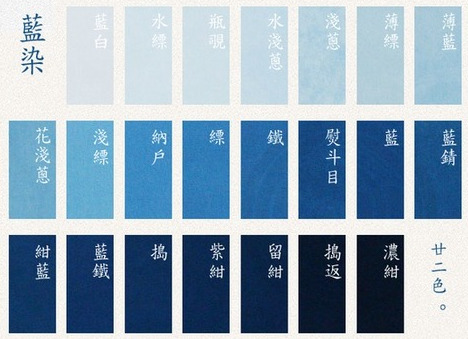

(I also must say that the lighter green-ish blue shade is called 水色 too. Literally the color of water. Commonly translated as aquamarine.)

Like the traditional Japanese blue shades, Sorey's blue is more on the deep indigo blue side in its hue and Mikleo's blue is more on the light aqua blue. Meanwhile, Water Armatus (the two of them) is the "balanced" blue in the middle.

(I have an entire Twitter thread too for this too here)
Finally, I want to talk about a certain saying that also originates from Nichiren Buddhism:

やのはしる事は弓のちから、くものゆくことは・りうのちから、をとこのしわざは・めのちからなり。
The original writing is rather hard to read because it’s written almost entirely in hiragana, but it can be transliterated as follows:
矢の走る事は弓の力、雲の行く事は竜の力、男の仕業は婦の力なり。
Which can be translated to:
It is the power of the bow that determines the flight of the arrow, the might of the dragon that controls the movement of the clouds, and the strength of the wife that guides the actions of a man.
(Remember, again, that Mikleo is connected to dragons/竜, that he is based on Azure Dragon/清龍, and clouds are connected to rain/water and thunder/lightning, two elements associated with Mikleo and Sorey respectively.)
This is from the letter of Nichiren Daishounin (日蓮大聖人). I hope the meaning is obvious enough even without my explanation.
The bow and arrow work in tandem. Without the bow, the arrow cannot work. Without the arrow, the bow cannot work either. It is in the relationship, that even a relationship between a husband and a wife is likened to this.

The same dialogue from the first Water Armatus battle above is repeated again in this scene:


MIKLEO: Sorey, I’ll do the aiming.
SOREY: Right. And I’ll pick when to fire.
Despite the Armatization being literally a process of becoming one, of two different physical bodies becoming one, interestingly the human and seraph still retain each of their own consciousness. They don’t blend into one, and the workings of this can be seen in Sorey and Mikleo coordinating to handle the timing and aiming, respectively, when in Water Armatus. Armatus does work in mysterious ways, and it perhaps cannot be described in feelings known to common humans.
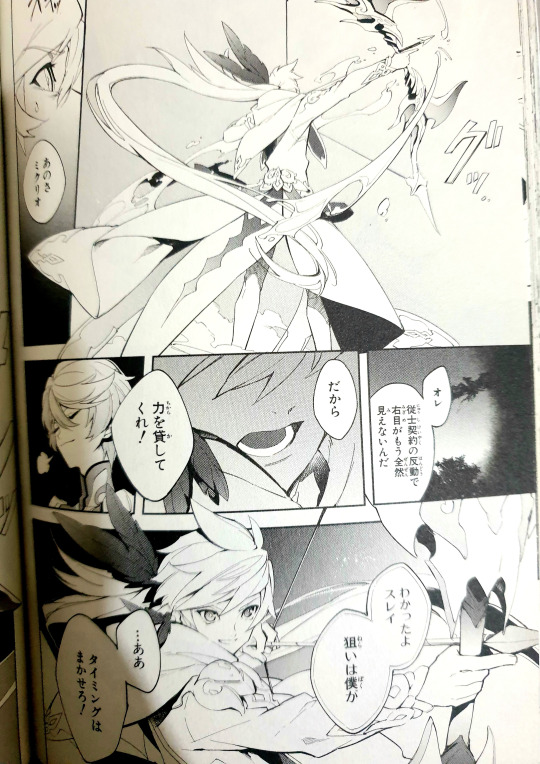
SOREY: By the way, Mikleo.
SOREY: Because of the Squire pact, I can’t see out of my right eye anymore.
SOREY: So...
SOREY: Lend me your power!
MIKLEO: Got it, Sorey. I’ll do the aiming.
SOREY: Right. And I’ll pick when to fire!
The manga outright makes Mikleo act as Sorey’s eye when aiming at the target, while Sorey handles the timing because of this. This communion, tacit understanding is a major part of their bond, after all, even without the Armatization. The novel also makes it a point that Mikleo offers to do the aiming because he has realized for a long time already that Sorey is blind on his right eye.
異体同心
種族は違うが、同じ想いを抱いて育った。人と天族の可能性を示す。
One Heart in Different Bodies
They are of different kinds, but they grew up embracing the same feelings. Showing the possibilities of humans and seraphim.
Exactly because they’re different that they can understand each other, can complement each other, as has been said before. I’ve talked about how Mikleo had needed to learn this, shortly, when I said he didn’t consider himself Sorey’s true friend, but even Sorey needed to learn about this.

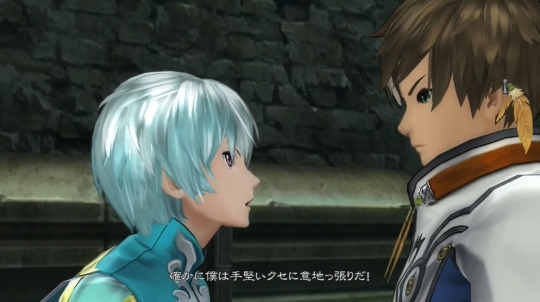











SOREY: Wait, hold on now!
MIKLEO: You’re right, I am stubborn as a rock!
SOREY: Huh?
MIKLEO: I admit it. I’m hell-bent on becoming a Sub Lord.
MIKLEO: But there’s something important that you don’t understand!
SOREY: I do understand! I just didn’t want you to get involved!
MIKLEO: Get over yourself.
SOREY: !
MIKLEO: Do you really think this is your dream alone?
SOREY: This is our dream.
Sorey’s flaw in the beginning is that he tends to carry everything by himself, that he doesn’t want the people he cares about to be hurt because of him (or what he thinks as his own responsibility, and not anyone else’s). He was alright with sharing happiness, but afraid to share anything else, even though it was implied that Michael failed as a Shepherd because he carried that burden alone. Even when Sorey and Mikleo fought (because they cared too much about each other), this had already had an effect on Sorey: he didn’t feel the excitement of exploring ruins, he couldn’t see the Earthen Historia, he wasn’t able to de-Armatize at will; and it was only when he accepted Mikleo’s offer to help him, that he could do all these and more (like how Alisha was finally able to hear the seraphim’s voices.)

MIKLEO: I know because it’s you; you were thinking that you didn’t want me to be involved, or that you didn’t want me to carry the burden.
MIKLEO: But it’s too late for all that.
MIKLEO: Our journey began a long time ago already.
MIKLEO: It’s not just your dream.
SOREY: ...Yeah.
SOREY: This is our dream!
A relationship is balanced if it’s two-way. Their bond is meant to show the limitless possibilities of how a human and seraph can work together to reach their dream together, the dream of coexistence, of being together. To be together is to share not just happiness but also sadness. It’s because life is not lived just by yourself alone, but also with others.
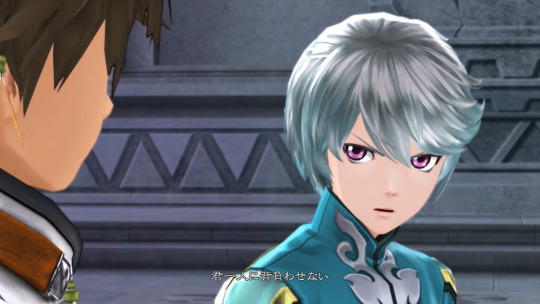
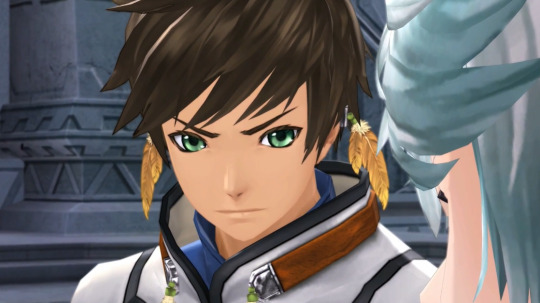
I won’t let you carry this by yourself.
Even until the very end. Just like the power of the bow determines the flight of the arrow, the arrow that flies straight and steadfast without any hesitation for its resolve, warding off anything that is evil, purifying the heart from taint, calling for friendly divinities to aid them. It will reunite them, the true friends, no matter the odds, just bet on that one chance. And this love is not to be denied.
You’ve matured through the course of this journey, and I’m proud of you for that, but don’t forget, I’m also here, right next to you, and I won’t let you carry everything by yourself.
唯一無二の
互いに誰よりも負けたくない相手。だから成長できる。今までも、これからも。
The One and Only
They do not want to lose to each other more than anyone else. That’s why they can grow. Until now, and from now on.
Mikleo is the best support Sorey could’ve gotten, even if he didn’t ask for him himself.
May these bow and arrow represent happiness and blessings, just as they used to in the ancient times long past.
弓を構えて真実射抜け
Pull the bow and aim for the truth.
#tales of#tales of zestiria#mino talks zesty#mino rambles#yet another#srmk lovemail#their divine bow is also the most beautiful divine artifact btw at least imo lol#sorey really needed to unlearn his meebogynist views lol#i am now emotional again over all the water armatus moments in the game#i did this to myself and now you all have to experience it too with me
35 notes
·
View notes
Text

Since @laindir mentioned something about Ratatouille!Dezel I decided to look up Gameplay Numbers for Snack Preparation.
First five rows are for failures. Not including those failures, there are 35 snacks that can be prepared. Numbers indicate the probabilities out of 100, so they are in percent essentially.
In terms of failure rate, Dezel cannot fail at all (0%), while Edna is most likely to fail (33%). The rank for failure rate is Edna (33%) > Alisha (17%) > Sorey (16%) = Rose (16%) > Mikleo (10%) > Zaveid (4%) > Lailah (3%) > Dezel (0%).
Not counting the failure stuff, Mikleo can make everything, while Edna can make the least (she can only make 14 snacks). The rank goes like Mikleo (35) > Dezel (32) > Lailah (31) > Zaveid (29) > Sorey (27) = Alisha (27) = Rose (27) > Edna (14).
Sorey and Rose might seem like they share similar stats here, but I think Rose might slightly be better at this since she has the highest chance (7%) of making the best snack in the game, Marron Glacé. Out of the humans (who all seem to be bad at this), Rose actually might be the best cook, despite trying to do so with abacus.
If we look at their specialties (by seeing which snacks have the highest possibility for each character)...
Sorey: Pear Compote (10%)
Alisha: Strawberry Waffle (12%)
Rose: Baumkuchen (10%)
Mikleo: Fruit Frappé (7%), Raspberry Mousse (7%)
Lailah: Strawberry Shortcake (10%)
Edna: Chocolate Rusk (12%), Palmier (12%)
Dezel: Baumkuchen (8%)
Zaveid: Grape Mille-Feuille (10%)
As seen from Sorey, specialty doesn't necessarily indicate favorite food. Here are some interesting tidbits:
Sorey can make his favorite, Soft-Serve Ice Cream, but out of the ones he can make, it has the lowest chance of happening (1%). I suppose that's because his favorite has to be specifically made by Mikleo (Perfect Guide's words, not mine), which has a 5% chance of happening, just below his specialties and Ice Pop. It's just when push comes to shove, like when Mikleo suddenly can't make it for him, he will make Soft-Serve Ice Cream himself... while crying.
Dezel and Rose share the same specialty. Makes you think.
Also, there's a skit where it's said that the way Dezel bakes Madeleines is similar to how Rose does it. The chances for Madeleines are 4% for Dezel and 2% for Rose.
You can definitely see from what they can make and their specialties that the seraphim's elements definitely have something to do with the snack preparation here, as mentioned in a skit.
And that's the useless Zesty knowledge of the day.
#tales of#tales of zestiria#also#we can conclude that dezel is the best cook#while edna is the worst one lol#mino talks zesty
34 notes
·
View notes
Text
Sorey, as the Shepherd and as a Human
Continuing from this post about the right hand and the left hand. There’s something in the final battle of Zestiria that doesn’t get talked about a lot too.
Namely that, he uses Lion’s Howl (獅子戦吼) with his left hand (the spiritual hand, the one with the Shepherd’s glove).

The same as in the OP, where he uses his left hand for the arte, focusing on the dragon crest on the Shepherd’s glove and with the four seraphim overlaid over him. It is essentially still him acting as the Shepherd, the vessel for his seraphim companions, against the Lord of Calamity.

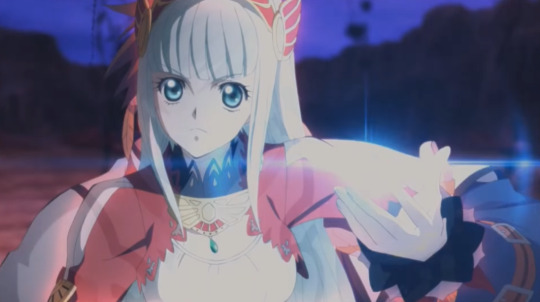



It’s the second strike of the arte that caught Heldalf, as the Lord of Calamity, off guard, from Sorey, as the Shepherd. Here, he uses his right hand (even the novel calls attention to this too as he explicitly uses the opposite hand) to bring out that second strike.
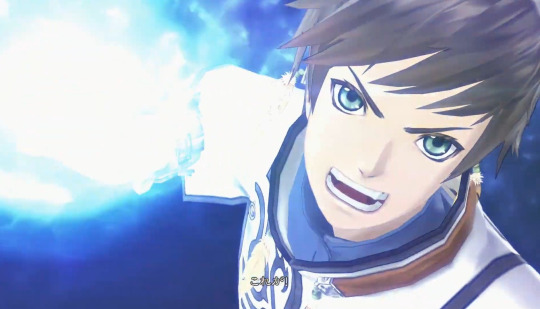


This is my everything!!
It’s the hand that symbolizes him as a mere human. In the novel, it’s said that after Lailah was gone (because she was shot as a bullet to sever the bond between Heldalf and Maotelus), Sorey no longer had the power of purification (the flame of purification). He was no longer the Shepherd here when he faced Heldalf one-on-one.
It’s even more clear-cut in the manga.

HELDALF: What can you do alone?
SOREY: I am not alone!
HELDALF: How meaningless... you still don't realize it, do you?! The effect of the emptiness that fills the world, the more you resist the more you feel... that is loneliness!
SOREY: There have been people who grasped back when I reached out my hand; and when they took my hand, they all could look forward.

SOREY: That’s why I won’t stop reaching this hand out!
BOTH: Lion’s Howl!
HELDALF: Behold! The fate of the black and white of this world, the Lord of Calamity and the Shepherd, that can only reject each other!
HELDALF: This is the world’s answer as repeated, as woven by time!
HELDALF: Even powers adorned with sophistry called purification or salvation are nothing more than violence in the face of that answer!
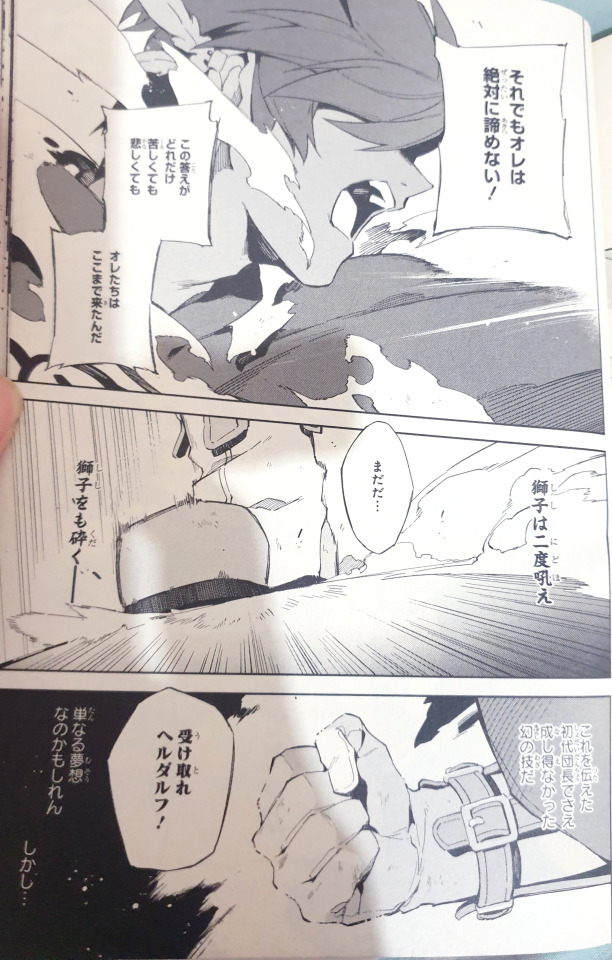
SOREY: Even so, I won’t ever give up!
SOREY: No matter how painful or sad this answer is, we’ve managed to come this far.
SOREY: Not yet...
(The lion roars twice, the lion shall be crushed—)
(Even the Captain who passed this arte on couldn't accomplish this fantastic feat.)
(Maybe it’s just a pipe dream, but...)
SOREY: Take this, Heldalf!

SOREY: This is my everything!!
SOREY: Bestial Roar!!!!
I’ve talked about how despite Zestiria seemingly being about Sorey and his spiritual journey as the Shepherd, on the contrary, the narrative actually pushes other ways of salvation beyond the power of purification itself. The first strike of Lion’s Howl was totally expected by Heldalf, who kept thinking of all this as the fate of the Shepherd and the Lord of Calamity.
What he didn’t expect was Sorey attempting to reach out to him not as the Shepherd quelling the Lord of Calamity, but a human wanting to save another human.
(His first strike of Lion’s Howl tore his Shepherd’s cloak and glove up, and he was now even more explicitly not the Shepherd, but Sorey as Sorey himself.)
It was why he was able to unleash the second strike of Lion’s Howl, Bestial Roar (裂震虎砲) (by the way, Rays also referenced Sorey using Bestial Roar, despite the arte not being in his moveset in the original game).
(There was everyone behind his back too; to his left, the seraphim, and to his right, the human companions he met along the way.)
This passage from the novel is a bit long, but I feel it’s important to Sorey’s resolution as his own person too (as a fellow, mere human).
「オレはヘルダルフがどうして災禍の顕主になったのかを知りたいんだ」
迷うことなく答えたスレイにメーヴィンは重ねて尋ねた。
「知ってどうする?あいつを倒す弱点を見つけたいのか?」
「それは……考えたことなかったな」
「なに?」
意外な答えにメーヴィンは眉間に皺を寄せた。
「じゃあ、なんのためにヘルダルフの過去を知りたいんだ?」
「導師として……ううん、オレがオレとしてヘルダルフと向き合うためだよ」
導師の使命は禍の顕主を鎮めること。スレイが導師になった当初、ライラはそう説明した。そのためには、世界を識る必要があると。
そしてスレイは旅に出た。出会いと別れを繰り返し、喜びと悲しみを繰り返した。どんなことにも裏と表があり、それらは切り離せない関係にあることを識った。
「旅は、導師として必要だったのかもしれない。でも、オレは導師であるまえにオレなんだ。世界を旅して、この世界が災禍の顕主によって危機に瀕していることを改めて識った。それを止めたいと思うのは、導師だからじゃない。オレ自身なんだ」
災禍の顕主は世界を穢れで満たそうとする、いわば大きな”負の流れ”だ。それと向き合い、抗おうとするなら—”正の流れ”になろうとするなら、相手を深く知り、正しく裏と表の関係にならなくてはいけない、とスレイは感じていた。
「導師として災禍の顕主と戦うだけなら、過去なんて識らなくてもいいかもしれない。でも、オレは識りたいんだ。自分が向き合うためには、それが必要だって感じてる。導師じゃなく、オレの勝手な願いだけれど、迷いのない選択をしたいから……メーヴィン、力を貸してくれないかな?」
メーヴィンは沈黙した。顔から笑みは消え、鋭い眼光がスレイを見定めるように行き来する。
スレイも沈黙し、メーヴィンの答えを待った。
やがて語り部は深くため息をついた。
「……なるほどな。使命じゃなく、己の意志で戦うことにしたってわけか……。確かにたいしたタマだったようだ」
“I want to know why Heldalf became the Lord of Calamity.”
Sorey answered without any hesitation, and Mayvin asked again.
“And what will you do once you know? Do you want to find a weakness to take him down?”
“I... had never thought about that.”
“What?”
Mayvin’s brows wrinkled at the unexpected answer.
“Then, for what reason do you want to know about Heldalf’s past?”
“I want to face him as the Shepherd... no, as myself.”
It is the Shepherd’s duty to quell the Lord of Calamity. When Sorey first became the Shepherd, Lailah explained this to him. In order to do so, he needed to know the world, she also told him.
Then Sorey set out on his journey. He had repeated encounters and farewells, experienced repeated joy and sorrow. He learned that everything had two sides to it, and that these two sides were inseparable.
“This journey might have been necessary for me as the Shepherd. But I am me before I am the Shepherd. Traveling around the world, I understood once again that this world is threatened by the Lord of Calamity. And I want to stop that not because I am the Shepherd, but because I want to do it as myself.”
The Lord of Calamity was a great “negative flow,” so to speak, that seeked to fill the world with malevolence. To face and resist this, to be the “positive flow,” Sorey felt he had to know the other party deeply and be on the right side of the relationship between the two.
“If all I want to do is to fight against the Lord of Calamity as the Shepherd, I may not need to know anything about his past. But I want to know; I feel that I need to in order to face him. It’s my own selfish wish, not as the Shepherd, but I want to make this choice without hesitation, so... Mayvin, will you lend me your strength?”
Mayvin was silent. His smile faded from his face, and his sharp eyes came and went as if he were assessing Sorey.
Sorey, too, was silent, waiting for Mayvin’s answer.
“...I see. So you decided to fight him not because of the Shepherd’s calling, but on your own will... you certainly have the gall to do it.”
To note here is how “識る” keeps being used instead of “知る” for the word “to know” even though they’re both read the same (しる). The game and manga do this as well. Like the words “刻” and “時” having the same meaning and reading but different nuance to them, this is also the same case: “識る” is to know in its entirety. To comprehend. To understand deeply, in every sense of the word. It is holistic.
(It all started when he thought he should’ve tried to know, to understand Dezel more.)
And it’s not like he has always known about this. Sorey at the beginning didn’t know that he didn’t have to carry the burden all by himself. He needed to learn that he was blessed with friends who would share it with him.
(It’s worth noting that every time Kimura, Sorey’s JP VA, is asked to describe Sorey’s character in interviews, he almost always answers that Sorey is a purehearted person with a good will, but more than anything, blessed with many friends who care about him as a person.)
「ロゼ、みんなに伝えてほしいんだ。オレたちのこと、天族のこと。世界を救うのは、これからのみんなにかかってるって!もう無知による悲劇を、共にわかちあわなかったせいですれ違う悲劇を繰り返しちゃいけない!」
“Rose, I want you to tell everyone. About us, about the seraphim. It is up to everyone from now on to save the world! We must not repeat the tragedy born out of ignorance, the tragedy of our failure to see eye to eye with each other because of not sharing together!”
He said, as he went to face Heldalf for the final time.
Unfortunately, Heldalf wasn’t the same. He was, indeed, cursed with the Eternal Solitude, however it was also Heldalf himself who didn’t seek salvation at the earliest opportunity. Sorey’s figure wasn’t even reflected in his eyes, even though Sorey tried to save him. He was too far gone, and even Sorey’s hand couldn’t reach him.
But that’s okay. Sorey understood that Heldalf had his own answer, and he wouldn’t let that answer be tainted by white (as Heldalf said, he wouldn’t give in to the white light), just as his own answer wouldn’t be tainted by Heldalf’s black. He was being true to himself, and saved Heldalf in his own way.
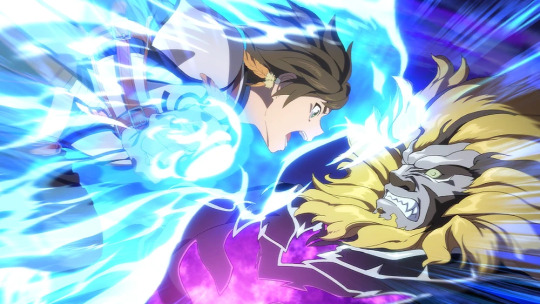
This is Sorey’s decisive battle mirrage in Rays, by the way, called “全身全霊の一撃”, which translates to “Body and Soul’s Strike.” In that one strike, he puts in his everything (全身全霊 = complete devotion, one’s whole body and one’s whole soul, literally). It is the conclusion he came to from all the time he experienced that led him to this point.
35 notes
·
View notes
Text
Mikleo’s Blessing
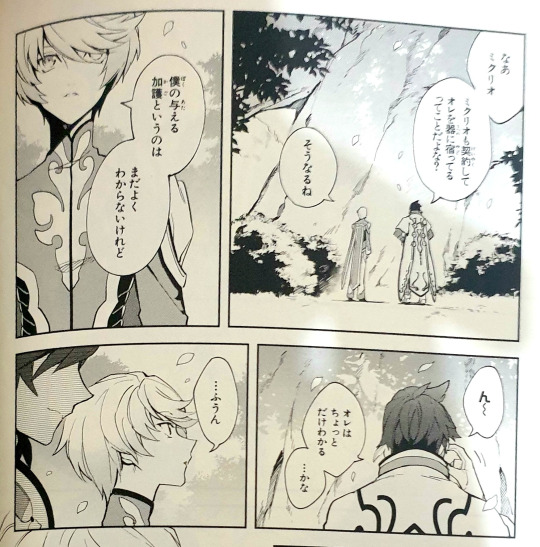
SOREY: Say, Mikleo. You made a pact, so I will be a vessel for you to dwell in, right?
MIKLEO: Yeah.
MIKLEO: Though I’m still not quite sure what kind of blessing I can grant to you.
SOREY: Hm~
SOREY: I have an idea of what it might be... I think.
MIKLEO: ...Hmm.
Seraphim are mysterious beings, even they themselves might not truly know the nature of themselves and their powers. What is at least known, is that each seraph can grant their own blessing.
Mikleo, as a young seraph (who might even be considered a baby in terms of seraph years), has always been depicted as someone who knows virtually almost nothing about being a seraph, even perhaps his own blessing. So I will try to surmise his blessing from hints from the game itself as well as supplemental materials (manga, novel, etc.).
Blessings, What They Are
To start, the idea of seraphim’s blessings in Zestiria is modeled after the beings they’re directly inspired by, kami, and the blessings that they grant, which can be seen as both blessing or something that brings upon harm, depending on how you look at it. The way they show how blessings work in the game can be a bit confusing, so let’s look how the official books define it.
First off, the Official World Guidance:
加護
天族は「加護」という形で、人々にさまざまな影響を与える。加護の内容は天族によって異なり、人々にとって必ずしもありがたいものではないこともある。それなら「災厄」と呼ばれるが、本質は同じ。たとえば天族サイモンが加護を与えると、その人物は望む夢を見ることができる。その幻に酔い、現実から逃避する人間もいるだろうが、それを加護ととるか災厄ととるかはその人次第といえる。
Blessings
Seraphim influence humans in various ways in the form of “blessings.” The blessings themselves vary from one seraph to another, and they may not always be appreciated by humans. In that case, they are called “disasters,” but they are essentially the same blessings. For example, if Seraph Symonne gives her blessing to a human, that human can have the dream they desire. Some people may be intoxicated by this illusion and escape from reality, but it is up to the individual to decide whether to take this as a blessing or a disaster.
Then the Perfect Guide:
天族の加護
天族は自然世界の根源に由来する力を持ち、自然現象の一環として創造・産出できる。この働きかけは天族の「加護」として、古くから人々の信心や崇拝の対象となってきた。よく知られているのは五大神信仰にもある「地水火風」の力だが、それ以上にもおよそすべての自然現象、人智の及ばない出来事は、加護によるものと言える。
加護の力と災い
天族の加護は多くの場合、人間にとって恩恵となるが、まれに人を傷つけ追い詰めることもある。風の天族デゼルや幻を操る天族サイモンの加護の資質がそれにあたり、彼らは加護を与えれば与えるほど災いを呼び、いわば人を不幸にする。こうした天族は「疫病神」とも言われ、その存在を人間が感知するかしないかに関わらず、禍事として疎んじられる。
Seraphim’s Blessings
Seraphim possess powers that originate from roots of the natural world, and they can create and produce those powers as a part of natural phenomena. These workings have long been the object of people’s piety and worship as the “blessings” of seraphim. What is well-known is the power of “earth, water, fire, and wind” which is also a part of the Five Lords faith, however, even more than that, almost all natural phenomena and events beyond mortal understanding can be attributed to blessings.
The Power of Blessings and Disasters
Seraphim’s blessings are often a boon to humans, but in rare cases they can also hurt and drive people away. The qualities of the blessings of Dezel, a wind seraph, and Symonne, a seraph that manipulates illusions, are such, that the more blessings they give, the more they bring misfortune, so to speak. These seraphim are also known as “yakubyougami,” and whether humans perceive their presence or not, they are shunned as disasters.
They more or less say the same thing, and the general idea is really the same as the blessings of kami. In the novel, Zaveid also elaborated on what blessings can be like:
「人を不幸にする加護ねぇ。まぁ、そういう天族もいるだろうな」
「そうなのか⁉」
聞いていたミクリオが身を乗り出す。
「まぁ、《加護》っていうからいいもんに聞こえるけど、結局は”人間側から見たら”って話なわけよ。天族の天響術がそれぞれ違うように、《加護》も様々だ。たとえば《植物の育成を助ける》って加護をもつ天族がいた場合、その天族と一緒にいる人間のまわりじゃ、植物が勢いよく育つ。その人間が農作物を作っているなら《恵み》と感じるだろうが、旅人だったらなんの効果もない。もしくは行く先がいつだって草ぼうぼうで《不運》って感じるかもな」
「じゃあ、デゼルの《加護》が不幸を招くっていうのは、どういう作用だったんだろう。サイモンはデゼルの願いが不幸を招いたと言っていたけど……」
「あいつの願いが不幸を招く?なんだそりゃ」
眉をひそめたザビーダに、スレイはサイモンの幻想で見せられたデゼルの過去について話した。聞き終えたザビーダは、頭をがしがしと乱暴にかき、深く息を吐いた。
「これは俺の憶測だが、たぶんデゼルの加護は《旅に恵まれる》だったんじゃねぇかな。風の天族にはそういう《旅》に関する加護を持つやつが多いんだ。デゼルの加護によって《風の傭兵団》の実績はローランス皇室に認められ、定住することになった。するとデゼルの《加護》は傭兵団にとっちゃマイナスの方向へ作用をはじめて、結果、傭兵団は解放。ロゼたちは別の形で旅を始めることになった……。《加護》ってのは、天族が人間と一緒にいたいと思えば、天族本人の意志を離れて発動する。幸せになってほしいと思う相手を不幸にするなら、そいつはたしかに”業”と呼べるかもしれないな」
“A blessing that brings misfortune to people, huh? Well, I guess there are some seraphim like that.”
“Is that so!?”
Mikleo, who was listening, leaned forward.
“Well, blessings sound like a good thing, but in the end, it depends on how the humans see it. Just as the seraphic artes differ from one seraph to another, so do the blessings. For example, if there is a seraph with the blessing to help make plants grow, then plants will grow vigorously around the person who is with that seraph. If the person is a farmer, they may feel it is a blessing, but if he is a traveler, it might as well have no effect. If anything, perhaps they’ll feel unlucky because there’s always grass wherever you go.”
“So how did Dezel’s blessing work to bring upon misfortune? Symonne did say that Dezel’s wish brought upon misfortune....”
“His wish bringing on misfortune? What the hell is that?”
To Zaveid, who raised his eyebrows, Sorey told him about Dezel’s past, as shown to him in Symonne’s illusion. When Zaveid finished listening, he scratched his head and deeply exhaled.
“This is just my guess, but maybe Dezel’s blessing is ‘good fortune for travelling.’ Many wind seraphim have such travel-related blessings after all. The achievements of the Windriders, thanks to Dezel’s blessing, were recognized by the Rolance royal family, and they settled in. Then Dezel’s blessing began to have a negative effect on the Windriders, and as a result, they were released. So Rose and her group started travelling again in a different way.... When a seraph wants to be with a human, their blessing will activate against their own will. If you want someone to be happy yet you bring misfortune to them, I guess you can call it ‘karma’.”
As well as an extra information:
「ザビーダ、よくわかるな」
驚くミクリオにザビーダは片目をつぶってみせた。
「長く生きてりゃ、いろんな奴と出会うからな。そういうのも自然とわかるようになる。……にしても、昔は《加護》の知識も当たり前だったんだがな、人と天族にこれだけ距離ができた今となっちゃ、埋もれた真実になっちまったか」
長命の天族が少し遠い目をして呟いた一言が、スレイの胸にずしりと刻まれる。
“Zaveid, you know a lot.”
Zaveid closed one of his eyes to the surprised Mikleo.
“If you live long enough, you will meet all kinds of people. And you will naturally know those things... even then, in the past, knowledge of ‘blessing’ used to be commonplace, but now that there’s such a distance between humans and seraphim, it’s become a buried truth.”
The long-lived seraph muttered those few words with a slightly distant look in his eyes, and those words were engraved in Sorey’s heart with a heavy thud.
So a relatively really young seraph like Mikleo naturally wouldn’t know about the details of blessings, since on top of everything, the only human he’d only known in life up until recently was Sorey anyway. Of course he never really cared about those when he thought he had no need of it, as someone living only among seraphim in Elysia, with practically no humans to give his blessing to.
(Or is there one...?)
To summarize:
Depending on the human who feels it, blessings can be a good thing, or be seen as misfortune. It’s on the human, which means the human is the one more likely to perceive [sense] it too, if they are conscious of it. Someone with a high resonance and pure heart like Sorey is sensitive to seraphim, so it’s very likely he can recognize it too, even if Mikleo is not aware of his own blessing.
Blessings vary from one seraph to another, but they seem to be related to their element (Dezel) and powers (Symonne).
Knowledge of it used to be commonplace but not anymore, presumably because of the distance that grew between humans and seraphim, there was no need for either to really know about each other, let alone blessings.
The more a seraph wants to be with a human, the more their blessing activates without the seraph’s control.
Almost all natural phenomena and events beyond mortal understanding can be attributed to blessings. Very important here.
Sorey, Heldalf’s Biological, Illegitimate Son
I know, I know, this theory is controversial... and a lot of people seem to consider this to be canon to manga only, however, what people don’t know is that the manga (along with the novel) was directly supervised by Hase, the director of the game and the lead creative, and Yamamoto, the head writer of the game. Shiramine even said that under such supervision, she rearranged the story, so that Zestiria could be enjoyed from another angle, and that every panel, every word was carefully chosen to tell this other version of Zestiria, because it would’ve been boring if it was telling the same story as the game, she thought, as an adaptation.
And I’m inclined to believe her words, since she seemed to be aware of stuff that a lot of official Tales stuff didn’t seem to be aware of. For example, if you pay attention to the positioning of Sorey and Mikleo in the manga, she seemed to be aware that Sorey is the Right (the human, the physical, the body) and Mikleo is the Left (the seraph, the spiritual, the heart) to each other, which a lot of other stuff got wrong, including TOZX. This is the kind of stuff that she would be conscious of if she knew about it, which she did.
Besides, I think the hints were in the game all along. Hase, the game director, told us directly to read between the lines, because everything is there for a purpose in Zestiria, so he’d be happy if we read too much into it. It might not be spelled outright, but there’s a reason why some things are inserted here and there. I think piecing Zestiria together through various media is also his way to have something for the fans to come to their own conclusion, to their own answer, on what Zestiria is really about.
With that in mind...
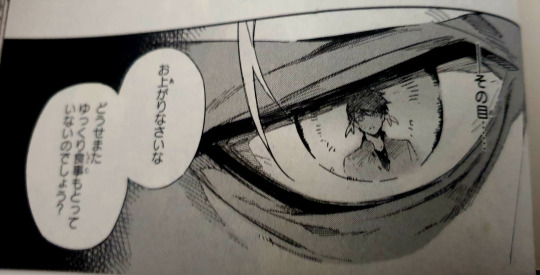
HELDALF: (Those eyes...)
SELENE: Please get your head up.
SELENE: You haven’t been eating properly again anyway, have you?
Selene said “again”, implying this is not the first nor second time she met up with him. That’s not even addressing the elephant in the room, in that Heldalf finally remembered about Selene, suddenly, when he saw Sorey [when Sorey is finally reflected in his eye].

SELENE: If you walk around with such a tired look on your face, everyone in the village will feel down too.
HELDALF: Do you not despair the reality of this invasion?
SELENE: I will not despair.
HELDALF: (Why do I remember this now...?)
SELENE: If we despair... what will guide the children who are born in this village and will eventually leave it?
HELDALF: (That which shone alone in the darkness....)
SELENE: As long as we do not give up hope, the future will be nurtured there.
HELDALF: (That figure....)
There’s a lot to unpack here, but the biggest giveaway is that Selene touched her pregnant belly, wearing what seems to be maternity clothes, talking about the future of the children. Theirs too, perhaps.

HELDALF: (Selene...)
She was really the last thing he remembered before his last breath, and why is that, especially if she was not an important person to him? (By the by, we’ll get into this later, but Heldalf is said to be a family-loving person.)
For the part where I say the game also has hints for this, I’d like to bring your attention to this skit, where the trio talked about Heldalf’s portrait:
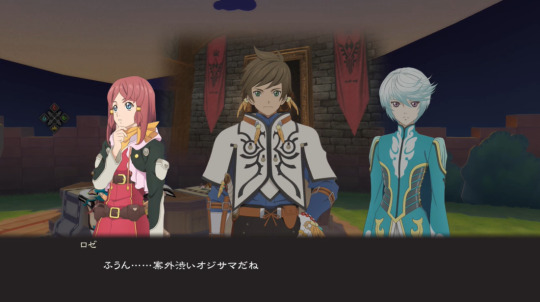


ロゼ「ふうん……案外渋いオジサマだね」
スレイ「うん。オレたちの父親くらいの年齢かな」
ミクリオ「二十年以上前の時点で、ね」
ROSE: Hm. Makes him look like a pretty distinguished gentleman, actually.
SOREY: Yeah. He looks maybe the same age as our dads, don’t you think?
MIKLEO: Or at least, that's how old he was 20-ish years ago.
Again, deliberate wording. When wondering about his age, Sorey told Rose that he looked like he could be their fathers’ age, to which Mikleo brought up “around 20 years ago”, give or take a few years.
More than 20 years ago was when Michael stopped being the Shepherd and founded Camlann Village, then 17 years ago was when the Age of Chaos began. But 17 is a specific number, and no one talked that specifically, so 20 years is a close approximate.
Which brings us to the beginning of it all.
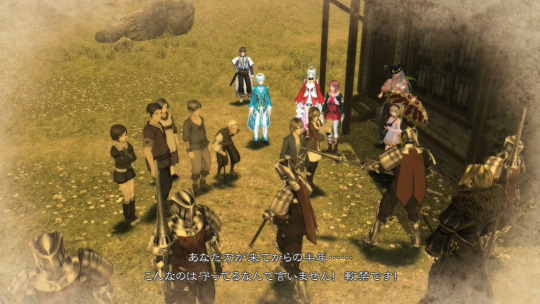
ミューズ「あなた方が来てからの半年……こんなのは守ってるなんて言いません! 軟禁です!」
MUSE: You have occupied our village for half a year now! This isn’t protection... It’s house arrest!
Keep this in mind: the Rolance army had been around in the village for about half a year. The army was hostile against the villagers, despite claiming to protect them. Muse was already holding a baby.
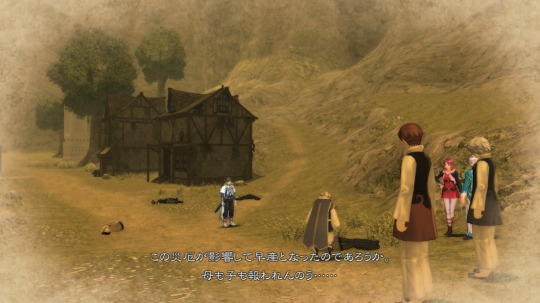

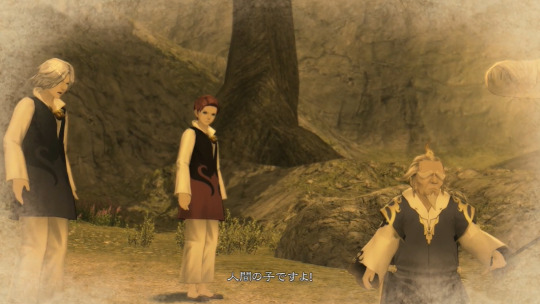
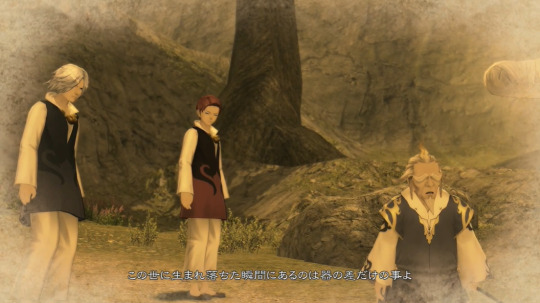


ゼンライ「この災厄が影響して早産となったのであろうか。母も子も報われんのう……」
ゼンライ「……これも縁か」
渋る天族「人間の子ですよ!」
ゼンライ「この世に生まれ落ちた瞬間にあるのは器の差だけの事よ」
マイセン「ですが、これほどの未熟児……持って数ヶ月では……」
ゼンライ「 ……かもしれんのう」
ZENRUS: Born far too early, by the looks of it. Poor mother and child... Neither of you deserved this.
ZENRUS: Perhaps this too is fate...
RELUCTANT SERAPH: That child’s a human!
ZENRUS: Are we not all the same when we first breathe this air, save for the vessel we chance into?
MASON: But a child born so premature won't last but a few months.
ZENRUS: Probably so.
Sorey, the human baby, was noted to be born prematurely. I’d also like to note that this sentence, この災厄が影響して早産となったのであろうか, directly attributed his premature birth to “this calamity” right after the scene in which Heldalf was cursed to be a hellion, the beginning of him becoming the Lord of Calamity. This will be relevant later on.
だが不意にゼンライは足を止めた。炎の音以外に、かすかだが別の音が聞こえたのだ。見遺れば、息絶えた女が胸の中に守るようにして赤子を抱いていた。災厄が影響して早産となったのだろう。赤子は生後間もない未熟児であった。泣く気力もないようだったが、それでも生きようと微かな呼吸を繰り返している。
「これも縁か……」
ゼンライは愛用のキセルの先を赤子へと向けた。すると、赤子を包むように小さな加護領域が展開され、ふわりと浮かび上がる。小さな加護領域は宙に浮かんだまま、ゆりかごのように揺れ、赤子を守った。
「ゼンライ様⁉ まさか、人間の子を助けるのですか⁉」
「この世に生まれ落ちた瞬間にあるのは、器の差だけの事よ」
渋る天族にゼンライは微笑み、さらに先へ進もうとしたときだ。
However, Zenrus suddenly stopped in his tracks. Besides the sound of flames, another sound was heard, albeit faint. When he looked over, he saw a woman who had died and was holding a baby in her arms, as if to protect it in her chest. Born far too early, must have been because of the calamity. The baby was premature. He seemed to have no energy to cry, yet he was still breathing faintly, trying to live.
“Perhaps this too is fate....”
Zenrus pointed the tip of his beloved pipe at the baby. Then, a small domain of blessing unfolded and floated gently, as if encompassing the baby. The small domain of blessing remained suspended in the air, swaying like a cradle, protecting the baby.
“Lord Zenrus!? Don’t tell me we’re going to save a human child!?”
“Are we not all the same when we first breathe this air, save for the vessel we chance into?”
Zenrus smiled at the reluctant seraph, about to move on ahead.
The novel went about the event almost the same way but confirmed that Zenrus used a domain of blessing to protect the baby.
Then Muse appeared right before Zenrus.
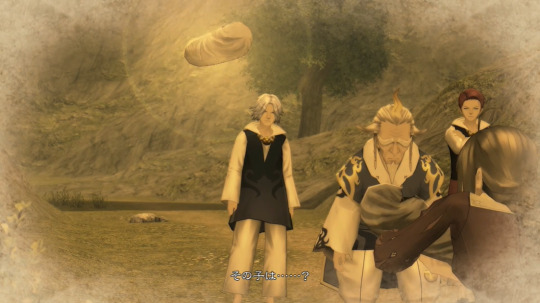

ミューズ「その子は……?」
ミューズ「セレンの……? 身籠もっていたなんて…… 」
MUSE: Who’s that child?
MUSE: Selene’s? Could it be she... She was with child?
Despite seemingly knowing Selene (and Camlann was said to be Michael’s family, which had to mean that they were at least a tight-knit community, especially since the village hid a secret that Maotelus was moved there), Muse wasn’t even aware Selene was pregnant. It’d make sense for Selene to try and hide her pregnancy if she had a baby with the leader of an army that was hostile against the villagers, lest she be seen as a traitor of sorts. Not to mention the fact that the baby was premature, and since the army had only been in the village for half a year, it’d still fit the timeline. Again, every line, every word is deliberate.
No changes for this in the novel. The manga went a bit differently, but conveyed the same idea.
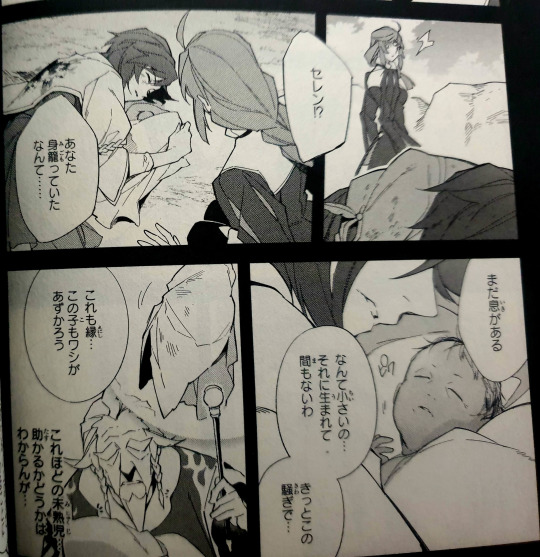
MUSE: Selene!?
MUSE: Could it be... you were with a child...?
MUSE: He’s still breathing
MUSE: He’s so tiny... he wasn’t ready to be born yet. It must have been due to all the stress...
ZENRUS: Perhaps this too is fate... I will take care of this child too.
ZENRUS: (Though, premature as he is, if he will survive....)
Of note: pregnancy that was not known to Muse, and Sorey’s premature birth.
This illustration for the manga countdown also gives us an idea that Muse and Selene were at least close:

Why is this all relevant? A passage on the Curse of Eternal Solitude should explain this (as seen in one of the Earthen Historia):
孤独の呪いは、彼の唯一の���いであった家族にも牙をむく。両親は病死し、二人の弟が戦で命を���とす。息子のひとりは火事で死亡し、別の息子と娘は首を吊って自殺した。さらに妻と幼い子ども3人が、馬車に轢かれて他界。12人の家族のうち、11人を短い期間で失ってしまった。悲しみに暮れるヘルダルフに残された希望は側室と、彼女がその身に宿した子どもだけだった。
唯一の希望だった、ヘルダルフと側室のあいだに生まれた新たな命。しかし、孤独の呪いから逃れることはできない。生まれた赤子は人間では���く、醜い鬼子だったのだ。あまりの衝撃に、ヘルダルフは自ら赤子の命を奪う。
The curse of solitude also bared its fangs on his family, which had been his sole salvation. His parents died of illness and his two younger brothers fell in war. One of his sons died in the fire, another son and a daughter committed suicide by hanging themselves. In addition, his wife and three young children passed away after being run by a horse wagon, leaving him to lose 11 of his 12 family members in a short period of time. The only hope left for Heldalf, who was lost in grief, was his concubine and the child she bore in her womb.
That was his only hope, the new life born between Heldalf and his concubine. However, there was no escaping the curse of solitude. The baby that was born was not a human, but an ugly demon child. To his great shock, Heldalf took the baby’s life himself.
The Curse of Eternal Solitude did not only turn Heldalf into a hellion unkillable by regular means, but also seemed to kill the people close and precious to him, which are his family. This family is not only his lawful one, since even his concubine and the baby from that concubine were affected by the curse as well, which meant it should’ve affected Selene and Sorey if she had a relationship with him and he was blood-related to him. And sure enough, Selene died, and her death always was seen after the scene where Heldalf was cursed, whether in the game, novel, or manga. However, for Sorey, Zenrus saved him in time before even the curse took effect (the curse seems to not take effect immediately, but it still managed to kill most of Heldalf’s family in a short amount of time), as he enveloped him in his domain of blessing, even though he wasn’t sure if Sorey would survive anyway in that state (he did, thankfully).
Sorey himself was aware that Zenrus was the one who saved him from “the brink of death” (Taizen page):
高い空の下で、ジイジは世界だった。
戦火に斃れた母から月足らずで生れ落ち、灼けた地面に投げ出されたまま、死の淵にあった自分を救ってくれた人。
Under the tall sky, Gramps was my whole world.
The one who saved me from the brink of death, as I was born less than a month after my mother died in a war and left me on the scorched ground.
Mikleo, the Healer and Protector
So then, where does Mikleo fit into all of this? When it was Zenrus anyway who saved Sorey? I would like to remind you, though, that since then, when Zenrus took over both Sorey and Mikleo, Sorey had never left his domain (Elysia was under his domain) until he left on a journey to the land below with Mikleo.
So I would like to propose this: Zenrus let Sorey survive the curse and grow under his domain, and everything afterwards, where Zenrus’ blessing cannot be felt anymore, it’s thanks to Mikleo.
(How he managed to grow healthy and strong, taller and more well-built than Mikleo, despite being born premature? Probably Mikleo as well.)
A seraph’s blessing is related to their element and powers, as well as influenced by their personal feelings. Healing abilities are often mainly associated with the element of Water, whether it’s Tales or other stuff. If we look at Mikleo, gameplay-wise, it’s the more obvious that he is intended as the Healer of the game, even if all the seraphim can heal, because it’s his designated role. And his healing is single-target too, which means it’s meant for one person only.
This is what the battle tutorial for his character says:


And this is what the description for Water Armatization says:


I’d also like to mention that the very basic of his healing artes, Resilient Aid, buffs the target’s Arte Defense stat as well:



This is sort of important, because as said in the description, how much a healing arte heals depends upon the target’s Arte Defense; the more of that stat they have, the more they get healed.
(His Map Action, Spectral Cloak, is also the only one that is protective in nature.)

I’d also like to look at Rays, but before that, let me explain what the deal is with Rays just so people who don’t play it can get it. The Tales characters you see in Rays are essentially the same as the ones in the original game canon; to put it simply, they are basically copied from their own canon selves, but get to live different lives in Rays canon. That’s the premise of Rays being a crossover.
Second of all, there’s a concept called Overray MA in Rays. Story-wise, Overray basically represents past and future possibilities that the character holds. In the case of Sorey, normally, because of the laws in Rays world, he can’t perform Armatization, so to work around this, at the time, he was able to use Water Armatization with Mikleo through Overray MA. That’s the gist of it.
What’s interesting is gameplay-wise. Here, I’d also like to mention that Udou Tatsurou, one of the lead designers in Zestiria, is himself the director of Rays. Udocchi, as he’s affectionately called by his peers and fans, is known for trying to integrate story elements in his gameplay, since he says that players rarely read manuals or help pages written by the devs, so he feels that they would pay more attention if it were said by their favorite characters (from an interview). In Zestiria, you could see this in the form of the Enemy Book conversations, or when your partner tries to tell you what to pay attention to in the battle, or the Monoliths, skits relating to the gameplay (e.g., skits about equipment fusion, that skit talking about elemental rock-paper-scissor relationship in the form of Edna and Mikleo talking about seraph weapons—nicely integrating worldbuilding into indirect gameplay explanation), etc.
Rays itself is known for neat details that only fans of original games would immediately notice and appreciate. For example, in the case of Zestiria, when you use Sorey’s Overray MA (so basically the Water Armatus), if you use earphones especially, you can hear Sorey’s voice from the right side and Mikleo’s voice from the left side. So Rays is definitely aware of the whole “Sorey being the Right (the Human, the Physical, the Body) and Mikleo being the Left (the Seraph, the Spiritual, the Heart) to each other” thing, despite, again, not many people (not even a lot of the official side people) being aware of this.
So how does all of this relate to his Overray MA, gameplay-wise? You see, the gameplay for Overray MA is basically that if you activate the MA, you will get special effects for a duration after it.

The special effect for Sorey’s Overray MA is “damage user receives cut to 1/4 for 15 seconds” which means, in this context, after Sorey calls Mikleo to Armatize with him (and Mikleo is there only for the MA), he de-Armatizes (back to just Sorey alone) and receives this effect, which reduces the damage that Sorey receives, to just 1/4 of it. That’s a huge amount of damage reduction (75%), and Sorey gets to enjoy this benefit. I choose to read this as Mikleo granting his blessing after their Armatization.
Which fits his personal feelings on this whole matter, anyway, if you read what he had to say about Sorey in his Taizen page:
幼なじみは里のみなの中でただひとり、あるべき力を欠いていた。弱く脆い、それが 「人間」 というものなのだと知らさてからは、彼と一緒にいるのが自分の役目だと信じて疑わなかった。
My childhood friend was the only one who lacked the power that he should have had, among everyone in our village. Weak and fragile; that is what it means to be “human,” and once I learned that, I believed without a doubt that it was my duty to be with him.
[...]
水は染まりやすく、いとも簡単にこぼれ出る。ささやかな迷いから穢れをたやすく寄せ付けて、己に触れる多くを濁らせてしまう。しかしまた、水は何かに寄り添うとき、己のありようをさまざまに変え、洗い濯ぎ、清めもできる。友の痛みが己を打ちのめす不幸のように心を抉るというのなら、怒り戸惑い、無力に涙しても、水の力を司るこの手で、友の道を妨げるあらゆる困難を排し、その歩みを穢れのないものにして見せよう。
Water is easily tainted and easily spills out. It easily attracts malevolence from the slightest hesitation and muddies the many things it touches. However, water can also wash, rinse, and purify itself when it comes close to something else, changing the way it is in various ways. If my friend’s pain gnaws at his heart like the misfortune that overwhelms him, if he is angry and confused, if he weeps helplessly, then with these hands that control the power of water, I will remove every obstacle in my friend’s path and make his steps untainted.
Finally, there’s also something in the original game that can also be connected to this whole thing. If you remember this title:
Peas in a Pod
Always there for you. Sign of a relationship where neither party even has to think about what they mean to each other.
It’s actually another idiom entirely in Japanese, 水魚の交わり, and if I were to translate things more literally:

水魚の交わり
側に居て当たり前。互いがどんな存在か考えるまでもない。そんな関係。
Like Water and Fish
It’s only natural to be by your side. Neither party even has to think about what they mean to each other. It’s that kind of relationship.
“水魚の交わり” as a saying refers to a relationship so close that it is inseparable, like how fish cannot live without water. However, taken more literally (which is why I tried to retranslate this in the first place), I personally infer this as Mikleo being the water (because of his association with the element) to Sorey’s fish.
The miracle of Sorey living despite of the curse is because Mikleo is there. Ironic, since Mikleo was also the very sacrifice used to curse Heldalf to his eternal solitude himself, but then this creates a cyclical relationship between Sorey, Mikleo, and Heldalf as well. Everything is interconnected, yet this will stay buried and unknown in the larger scheme, in history.

(Sorry for my ugly diagram, lol.)

MIKLEO: Still though, it’s thanks to Gramps and the others that we’ve come this far, and that you’ve grown up from such a small boy to such a fine man.


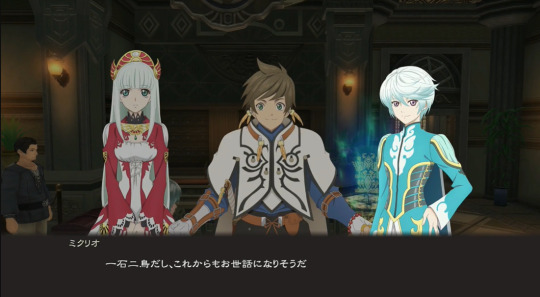

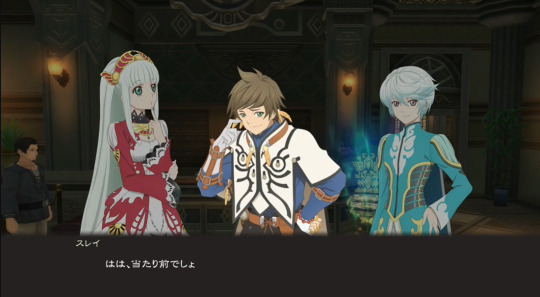


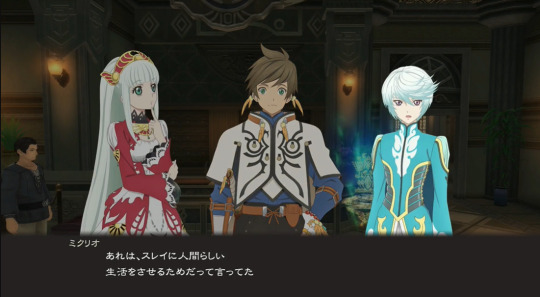
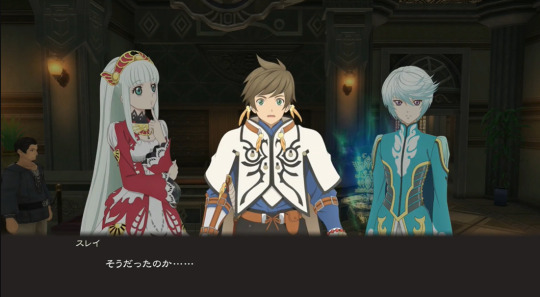
スレイ「なかなか美味いよな!宿屋の料理 」
ミクリオ「ああ。料理店を兼ねているのはいいな」
ミクリオ「一石二鳥だし、これからもお世話になりそうだ」
ライラ「ミクリオさんは、食事をなさるのですね?」
スレイ「はは、当たり前でしょ」
ミクリオ「いや。天族は食事をとる必要はない」
スレイ「ええっ!?ジイジたちもみんな食べてたじゃないか」
ミクリオ「あれは、スレイに人間らしい生活をさせるためだって言ってた」
スレイ「そうだったのか……」
SOREY: Oh, man, this is the best food I’ve had in ages!
MIKLEO: Yeah. A quality inn and a quality restaurant, all in one.
MIKLEO: Smart combination there. I have a feeling we’re going to be regular customers.
LAILAH: Mikleo, do you eat?
SOREY: Hah! Sometimes he even breathes!
MIKLEO: What she means is, seraphim don’t actually have to eat to survive.
SOREY: What?! But you, Gramps, everyone back in Elysia ate food all the time...
MIKLEO: Gramps said that it was because we wanted you to experience life like a human.
SOREY: Oh... I... I didn’t know...
As much as he is the child of miracles, one who always goes against all odds, in the world of Zestiria, everything has a reason behind it, even if that reason might be beyond what humans could understand. In this case, I want to believe that those miracles are because Sorey has his family and friends, in Elysia, in elsewhere. I’m so glad he was able to grow healthily to be a kind person despite his poor birth circumstances, but more than anything, that he was surrounded by such loving family and friends. Sorey is truly blessed, even centuries into the future.
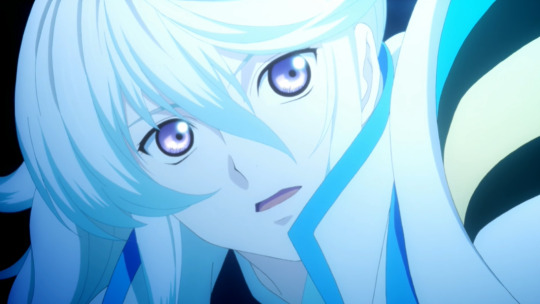

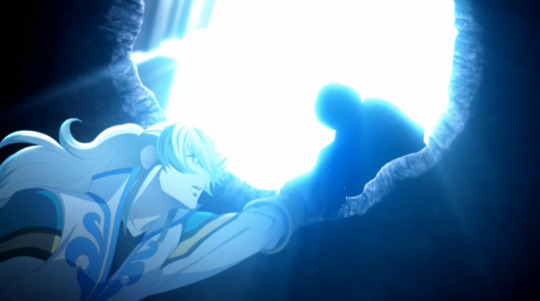


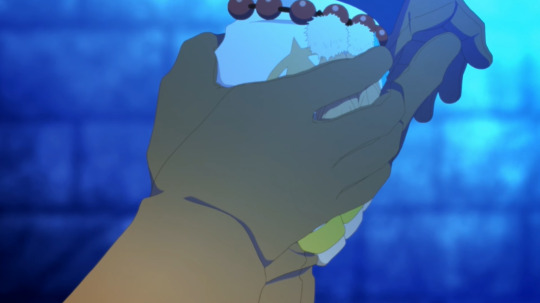
馬場 そしてミクリオが違う姿で登場し、冒頭のシチュエーションと同じようにガクっといくときに、手をふっと差し伸べるあのシルエットがね。
長谷 あそこに至るまでおそらく数百年は経っていますからね。
馬場 スレイがあそこまで冒険して、決断して、眠りについてまた出会うという流れは、ミクリオがあってこそだと思うので。
長谷 人間と天族の共存を象徴するのがあの2人の絆なので、どういう決着にするかはいろんなアイデアが出ましたね。
BABA: And then Mikleo appears, looking different, and just like the situation at the beginning of the game, when he falls down, there is that silhouette of that person holding out his hand.
HASE: It probably takes a several hundred years to get there.
BABA: I think Mikleo is exactly the reason why Sorey could get there; could go on such an adventure, make his decision, go to sleep, and then meet him again.
HASE: Since the bond between the two symbolizes the coexistence of humans and seraphim, there were many ideas on how to put a conclusion to their story.
#tales of#tales of zestiria#mino rambles#VERY VERY LONG POST with lots of pics like usual lol#this is now my srmk lovemail#please don't mind me#behind every great human is their seraph partner lmao#mino talks zesty
29 notes
·
View notes
Text
Right and Left, Human and Seraph, Physical Body and Spiritual Heart
Warning: Zestiria and Berseria spoilers.
右手は身・体の、左手は霊・心の在処
The right-hand side is where the physical body is, while the left-hand side is where the spiritual heart is.
I think it is already pretty well-known that humans are mostly right-handed and seraphim are left-handed in Zestiria, which is why Sorey and Mikleo stand on the right and left sides respectively when with each other, except for when Sorey was blind on his right eye in which Mikleo would switch to the right side to cover Sorey’s blind side. Referenced again during the night before the final battle, as a way for Sorey to ask for support.

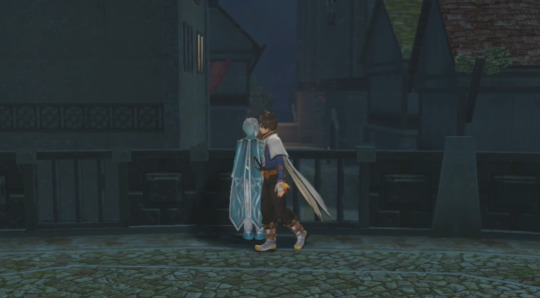

But aside from this, I think there's some pretty interesting stuff. The obvious one is that Sorey was specifically blind on his right eye, representing his humanity. As the Shepherd’s burden got into him, his senses that make him human got dulled. In this case, he lost his sight too. Let’s go earlier than this though.

Obviously, the right hand being his dominant hand made him catch Mikleo in the beginning of the game with his right hand, in reflex. He was very much still “Sorey, the human” (albeit among the seraphim) here, not even a Shepherd.
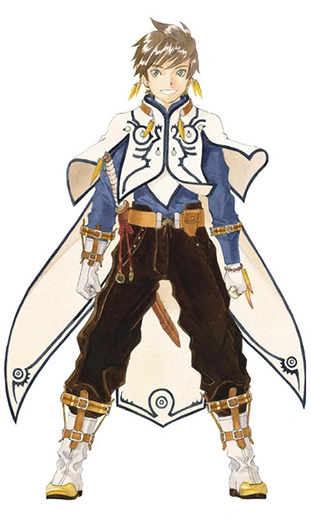
The Shepherd’s glove is on his left hand, by the way. Pretty apt since the left-hand side is for the heart/mind. Pretty relevant later on. Also, as someone brought up in a seraphim community, his sword sheath funnily is on the right side, even though he is right-handed, making it look a bit difficult to pull out.

In the epilogue, which is a callback to that scene mentioned above, he used his left hand (with the Shepherd’s glove) to catch Mikleo. Sure, it might be to show through the Shepherd’s glove that it is undoubtedly Sorey who caught him, but think back to the whole right eye being blind and the side-switching. This is Zestiria, the game where the director explicitly said to read too deep into it. He now used his left hand instead of his dominant right hand like in the beginning.
Also back to the night before the final battle scene. Sorey walked to the left side specifically after Mikleo asked, “But... you understand the implications, don’t you?”
Physical senses are a way for humans to receive information from the outside world. When they are shut off, the physical body basically ceases to function. Sleep can be read as a metaphor for death as a human in this case.
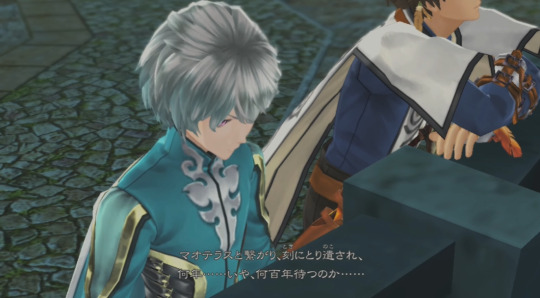
MIKLEO: By bonding with Maotelus, you'll be abandoned in time. It could take years... It could take centuries.
Note the use of “刻” for “time” here, as explained before. The passage of time differs between humans, and seraphim (and also Storytellers... while we’re at that. EDIT: Here’s another thing to think about, if you want to go into that rabbit hole of Storytellers.)
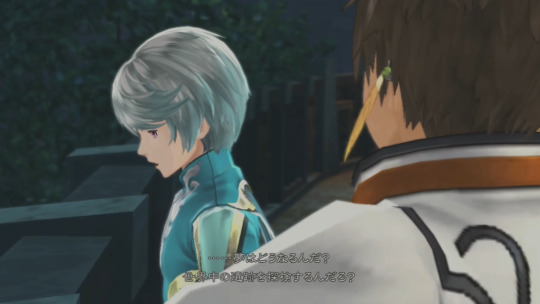

MIKLEO: What about your dream? Weren’t you going to go off exploring ruins around the world?
SOREY: My dream will live on, so long as I don’t forget.
Why bring up “so long as I don’t forget” in the first place? Will Sorey even forget about his dream that is basically the core of his character? Unless he knew of the implications?
Makes you think....
(A bit of a sidetrack here, but I feel the “オレが忘れない限り[夢は]終わらない” line is a nice nod to the OP of the very first game in Tales series, Tales of Phantasia, titled “夢は終わらない” which translates to “the dream will not end”)

If such seraph and human—heart and body could exist together, if the physical body could not lose sight of its own heart, could listen carefully to its voice, and could feel its presence, then humans should be able to live the way they want to live, without being tainted. Sorey, who has lived with the seraphim, is that proof.
By the way, speaking of heart and body, let’s talk about Innominat. Innominat seems to be a special seraph/malak in that a ritual has to be done to resurrect him, which is done by sacrificing one person to be the body and another to be the heart. There’s a distinction between “resurrection” (復活) and “reincarnation” (転生). According to Berseria Official Complete Guide, this is normally done at the same time, but during the events of Berseria, the revivals for the body and the heart were done at different times. It’s not known how the normal process would end up, but there’s a chance that the normal process would result in Innominat as a whole with his body and heart in one instead of separate like in the game. As a note, the anomaly process done in the game resulted in Innominat using Laphi as yorishiro; meaning that he’s not actually Laphi reborn as a malak, just inhabiting his (reincarnated) body without having any heart. Basically a heartless being with Laphi’s body and memories, which he can use to taunt Velvet. Because of this, even though Innominat says “I love you” to Velvet, there’s no actual emotion in that (Berseria Official Complete Guide). The heart lies elsewhere in Phi, who has Innominat’s calming and raising resonance powers.
So, ironically, since he’s basically a hollow body, Innominat, despite being a seraph, uses his right hand in his MA.

Aaaaand while we’re at this, since we’re on tangent anyway, here’s other stuff relating to right-hand and left-hand sides (human and seraph, physical and spiritual, body and heart) in both Zestiria and Berseria.

Eizen’s glove that gets handed down to Edna was the right-hand side one, while the flower that symbolizes her as the early bloomer is on the left-hand side, if you want to think more about it.

Velvet’s daemon arm is her left arm. Her humanity (right hand) is pretty much still in tact, compared to...

Artorius, whose right arm he had lost use of already.
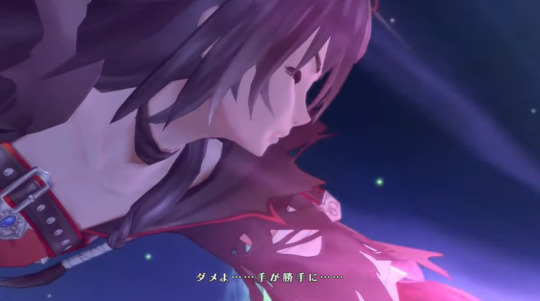

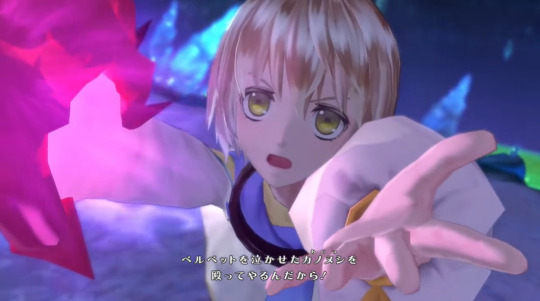

Phi said he didn’t care if Velvet ate his [right/human] hand, as long as he still had his [left/seraph] hand, which he used to reach out to Velvet’s [right/human] hand. Just as Sorey and Mikleo are the “right” and “left” to each other, Velvet and Phi have been described as the “dark” and “light” to each other.
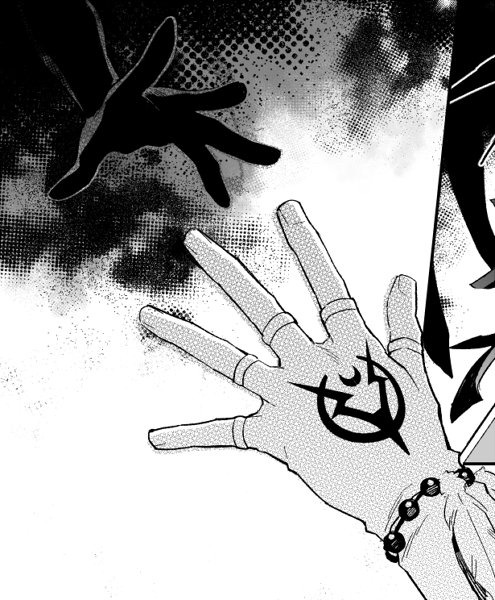
When Sorey reached his hand out* to Maotelus’ past in the manga, he used his left hand, while the one he reached out to used his right hand. Maotelus taking the form of dragon (a basically tainted seraph with no way of going back) as a part of his oath is because he believed in humans, that no matter how tainted he becomes from their ugly side, it is still a part of those humans, and that someone will come save him someday too.
*Shiramine has been on record saying that even if it is believed that a Shepherd’s powers are needed to save others [from malevolence], on the contrary, Zestiria actually pushes for other ways of salvation. Not just death, which Sorey had to learn (sometimes the hard way), but also salvation by reaching out. Though, even then, there are places that even Sorey’s hand cannot reach.
Also, if you notice, when using the Map Actions (of which the powers belong to the seraphim), Sorey activates those using his left hand. The same as when he armatizes, his left hand becomes his dominant one.
#tales of#tales of zestiria#and since it's only as a p.s. note and not actually the main part of the post#i am kind of reluctant to tag this as bersy#mino talks zesty
29 notes
·
View notes
Text
Some Zestiria characters actually seem to be named after flowers.
Rose is the most obvious one. Roses in general have many meanings in the Japanese flower language (love, beauty, etc.), but the red one means “passion.”
Edna is talked about in a skit in the game, but it’s actually a real flower. Edna ‘Stumperland’ is a kind of an orchid, and the variant doesn’t really have a meaning in the flower language, but if you look at red orchid’s flower language (ednae are a kind of red orchids), it means “happiness comes flying in.”
Alisha (アリーシャ), I think, is from アリシア, a type of rose (more specifically, the pink-colored one). The meanings for this variant are “gratitude” and “open-mindedness.”
Lailah is a bit less obvious than the others, but it’s lilac. It’s more obvious in Japanese (ライラ for Lailah, ライラック for lilac). Its meaning is “purity” among other meanings.
Mikleo is even less obvious, since the flower he’s named after doesn’t really have a recognizable name in English. In Japanese it’s rather obvious (ミクリオ from ミクリ) and its only meaning is “the pain of love.”
Sorey is the least obvious of them all I think. His name (スレイ) might come from water lily in Japanese (スイレン) (as a sort of annagram with one less character), the flower known as the water goddess. Its meanings are “pure heart” and “gentle.” (Speaking of annagram, Sorey is also an annagram of Rose but with an extra letter, so there’s that, which makes it that the human characters seem to be named after roses to some extent.) (By the way, blue roses mean “to fulfill one's dream” “divine blessing” “miracles.”)
Still have no idea about the wind seraphim, unfortunately, lol. Though Dezel (デゼル) might come from daisy (デイジー), befitting since daisy is said to be the flower of day's eye? And one of its meanings is “the unconscious” but that’s kinda. A reach.
25 notes
·
View notes
Text
I know this may seem so sudden but I unironically love how vague Zesty can be sometimes, that every time I come back to it, I will probably learn something new about it.
And tbh that’s probably intended too. The main reason I probably keep coming back to this game no matter how much time has passed is because I agree with the way Hase Yuuta (the director of the game) thinks.
From his interview in the Complete Guide:
説明しすぎるとかっこ悪いというか興をそいでしまうので、大事なところは秘めています。表情で描いたり、背中で語らせたりと演出には気をつけたかったので、「深読みかな?」と思うくらい読んでいただけるとうれしいです。
If I explain it too much, it would be uncool, or rather, not intriguing, so I hide the important parts. I wanted to be careful with the direction, such as depicting it with facial expressions or body language [i.e. through the way they act, not what they say; speaking with their backs], so I would be happy if you were to read into it while thinking “Am I reading into it too much?”
Also earlier, from his interview with Famitsu:
最後に、ゲーム全体についてお伝えさせてください。作中のあるシーンで、スレイが言う「自分で見つけるのが探検の醍醐味じゃないか」というセリフ。ここにこだわって、今回のゲームを作り上げた面があります。バトルも、探索も、そして物語も、ゲームのあちこちにお楽しみや解釈のヒントが散りばめられていますから、ぜひ皆さんのお好きなように進めて、最後まで楽しんでください!
Finally, let me tell you something about the game as a whole. In one scene, there’s a line where Sorey says “Isn’t discovering things by yourself the best part of exploration?” This is one of the aspects of the game that we focused on. There are hints of interpretation, of fun things that you can look forward to, scattered here and there in the game: in the battles, exploration, and even the story, so please enjoy the game the way you want to play it until the end!
It’s things like the game (or anyone involved in the game, in any interview, ever) never really brings to your attention that Sorey (or humans in general) being right-handed and Mikleo (or seraphim in general) being left-handed actually explains why Sorey stands on the right side and Mikleo on the left, except for the time Sorey was blind on the right eye that Mikleo covers his right side (in cutscenes, in skits, in battles...), and that Sorey moving to Mikleo’s left side on the night before the final battle scene as a way to ask his support once again. But that’s just one example.
I love how this idea is reflected in Sorey as the protagonist too. I mean, they mentioned about his quote above, but there’s something alluring about a game that doesn’t really explain itself, lol, like uncovering the mysteries surrounding the world it takes place in (it helps that Sorey is naturally curious about the world around him... his curiosity is contagious LOL). This might seem like I excuse what might seem like poor worldbuilding/storytelling to others but that’s exactly why I find Zesty fascinating the way I don’t find a lot of things are lol.
tl;dr I love how there’s probably a lot of things not set in stone by the creators in Zesty and I wish there were more stuff like it because there are not a lot of stuff quite like it. I love to read too much into stuff, let me do it.
#tales of#tales of zestiria#mino rants#or maybe more aptly#mino rambles#sorry for saying a whole lot of nothing in a really tl;dr way#mino talks zesty
27 notes
·
View notes